July/August 2012
Back to Project Contents and Introduction
July saw some intensive work being undertaken on the site of the amphitheatre, read all about it here.
After a lot of waiting both for better weather and special permission from Natural England to disturb the turf we were able to start work on Church Oakal B site on Monday August 13th. and two weeks later kick off on Church Oakal A site. You can read about our progress, day by day, below.
After a lot of waiting both for better weather and special permission from Natural England to disturb the turf we were able to start work on Church Oakal B site on Monday August 13th. and two weeks later kick off on Church Oakal A site. You can read about our progress, day by day, below.
DIG DIARY- Church Oakal A site
Monday August 27th to Friday August 31st. 2012
DIG DIARY- Church Oakal B site
Monday August 13th to Friday August 21st. 2012

Location Plan
Monday August 27th to Friday August 31st. 2012
We
were not
due to start until Monday August 27th. but we did pop down on the
preceding
Wednesday to relocate the electric fence from the top of the hill, so
Richard and Stephen could get the grass cut on Friday morning. We
applied to the National Trust
to be allowed to extend the planned trench from 4 metres to 6 metres in
order
to get a useful section across the earthworks and permission was
granted so we could mark out an appropriate area once the grass was
cut. The trench was designed to determine the nature of the moated
site identified in the valley bottom - medieval moated manor or
Jacobean
garden feature? Well we should know by the end of the week.
The forecast for Monday was dreadful but then it is an August Bank Holiday so what do you expect?
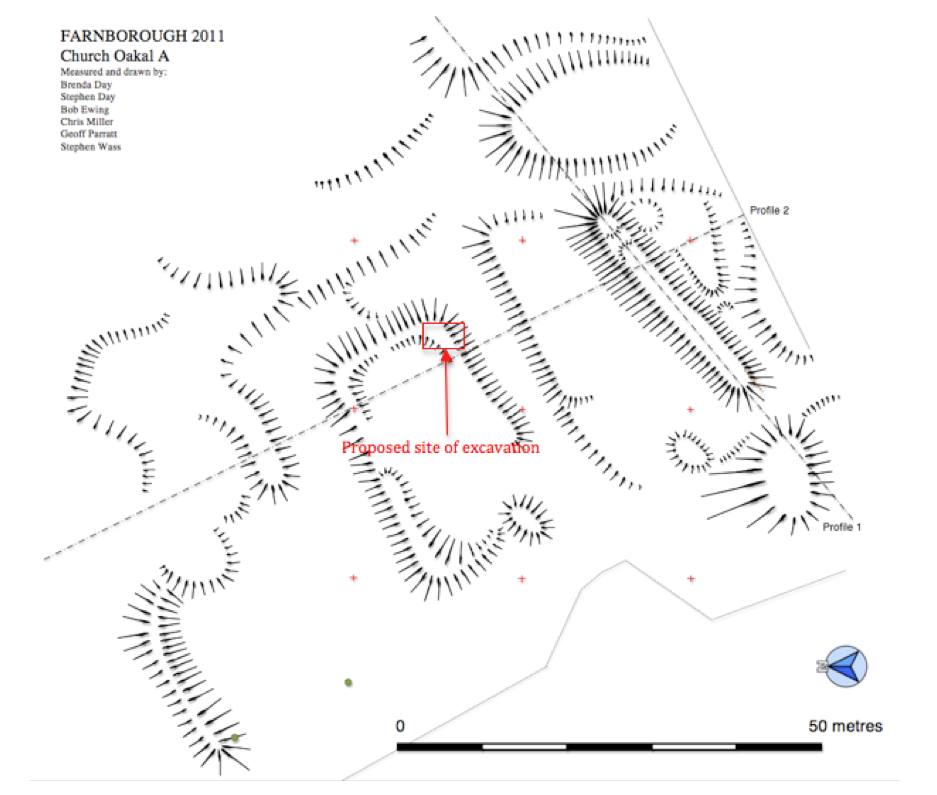
Location Map
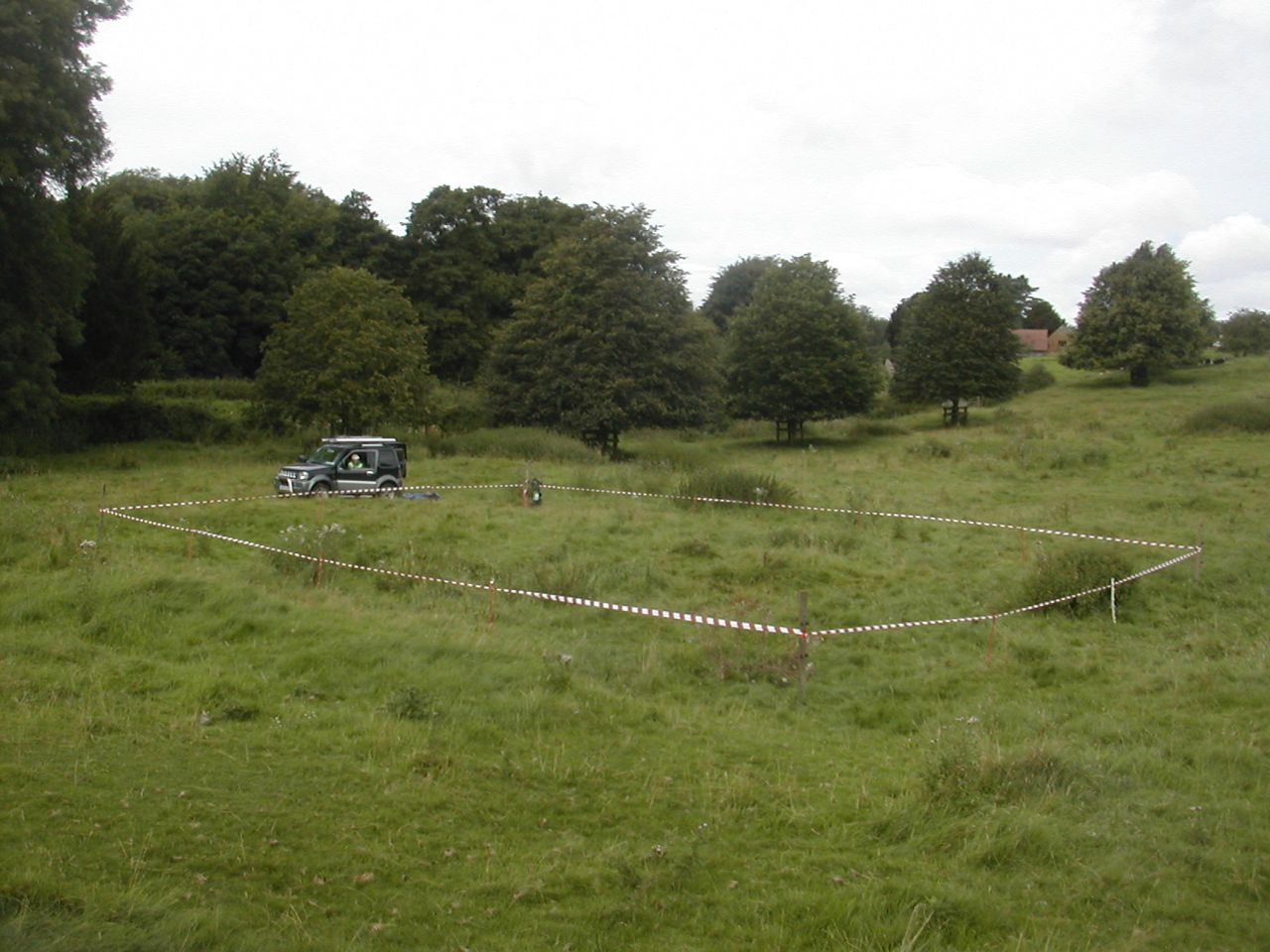
All fenced off and ready to go again.
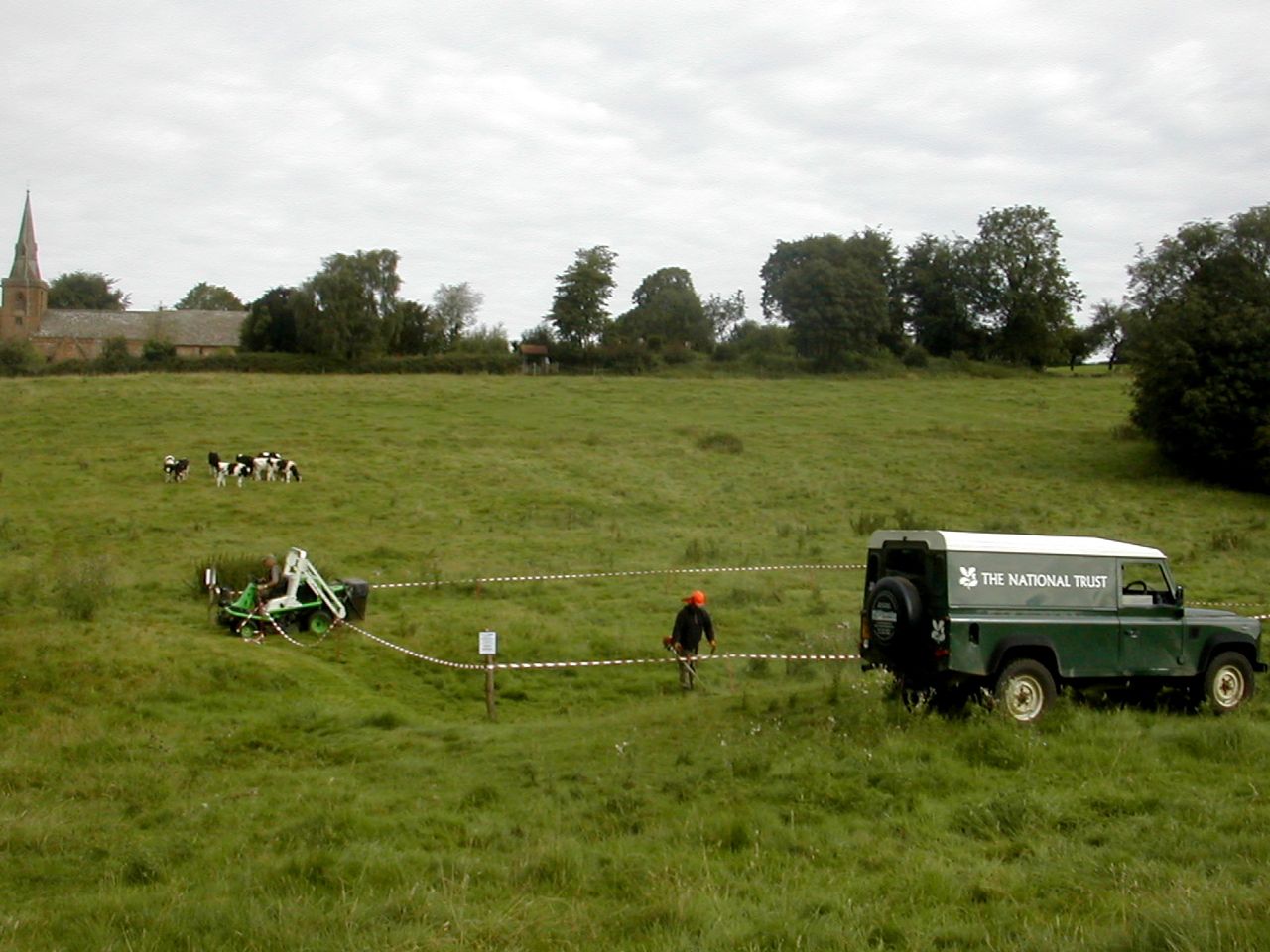
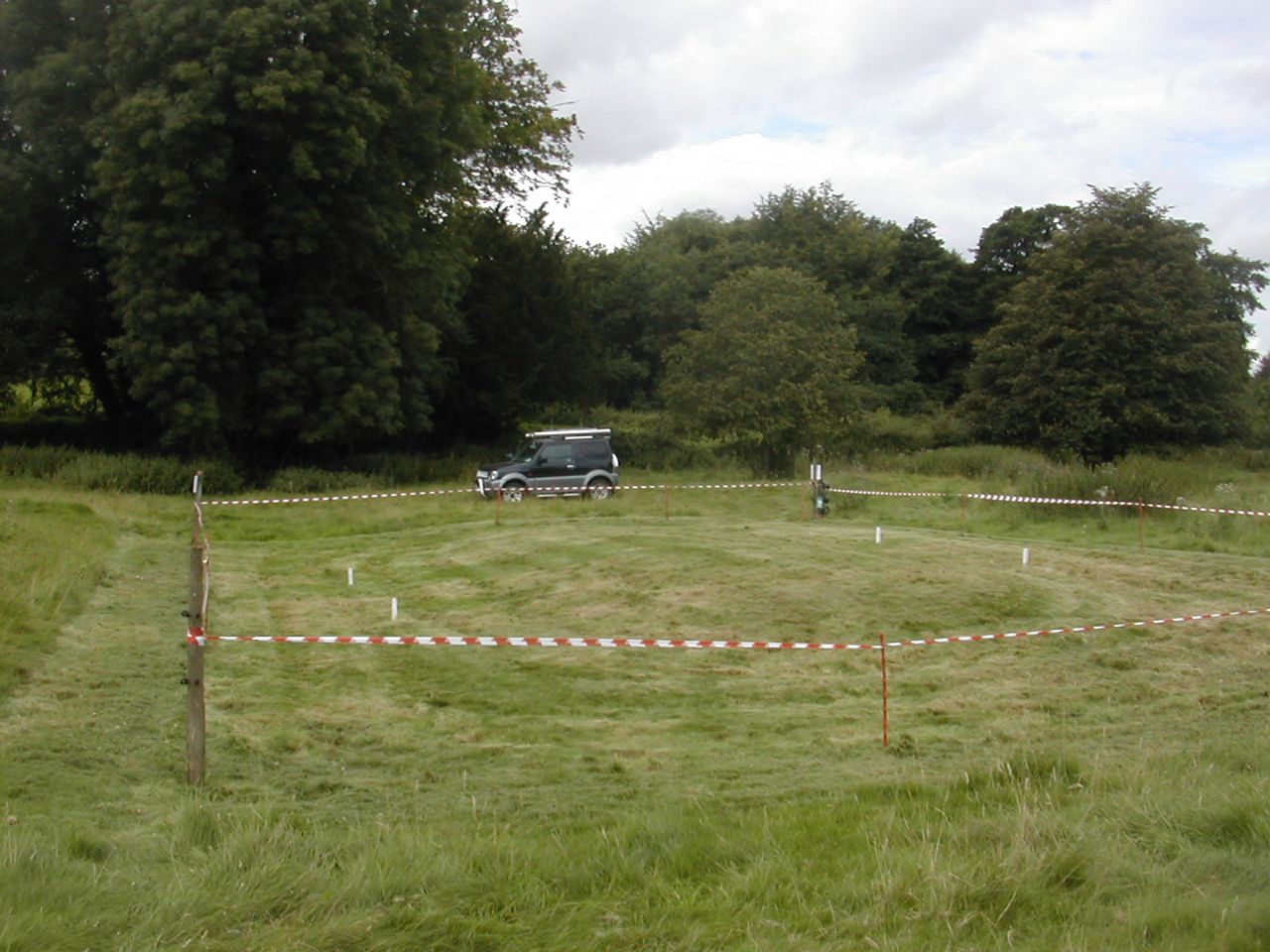
Friday August 24th. - the grass is cut and the setting out done.
The forecast for Monday was dreadful but then it is an August Bank Holiday so what do you expect?

Location Map

All fenced off and ready to go again.


Friday August 24th. - the grass is cut and the setting out done.
Monday August 27th.
Well the weather let us down again - we were expecting rain and we didn't get it! So good news and in fact we had a tremendous first day. With help from Samuel who came back for more and three new recruits: Isabel, Kathryn and Naomi, Verna and I were able to lead the team in making terrific progress. We were also delighted to see Chris Mitchell, a long term supporter of the project who came to document the first day with his usual collection of high quality images.The turf was removed and stacked by lunchtime and the surfaces revealed were cleaned up by teatime revealing a fascinating collection of walls, revetments and buried deposits and layers. Finds included some massive floor tiles and a couple of very fine microliths, possibly Mesolithic. Early indications are pushing us towards the medieval manor interpretation but it is still early days.
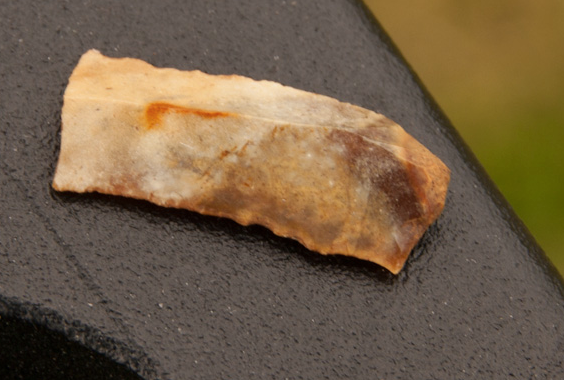
One of our two microliths, the blade is around 12 mm long. (Photo by Chris Mitchell)

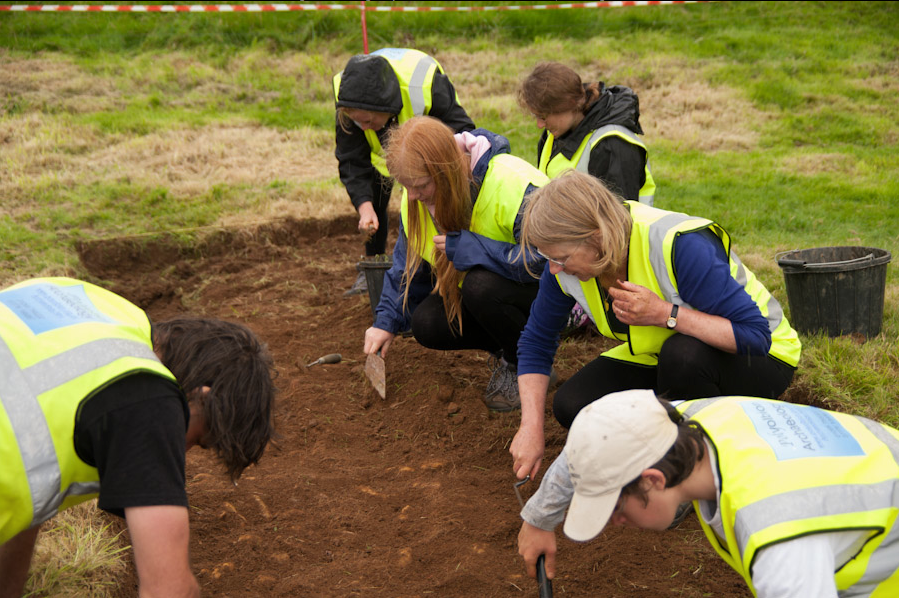
The turf stripping begins... and once it is all off we clean up the surfaces below...
(Photos by Chris Mitchell)
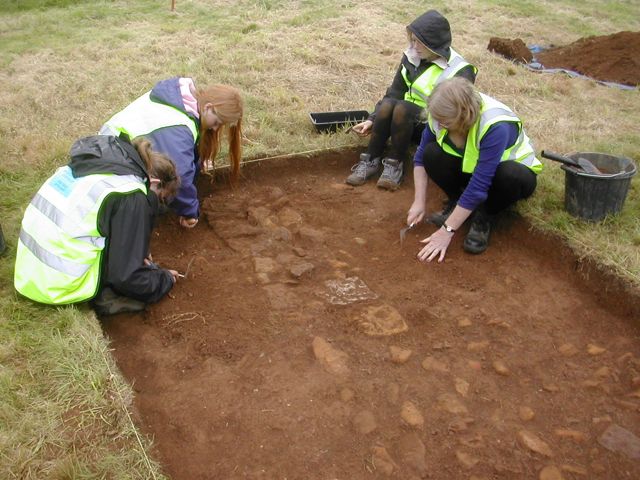
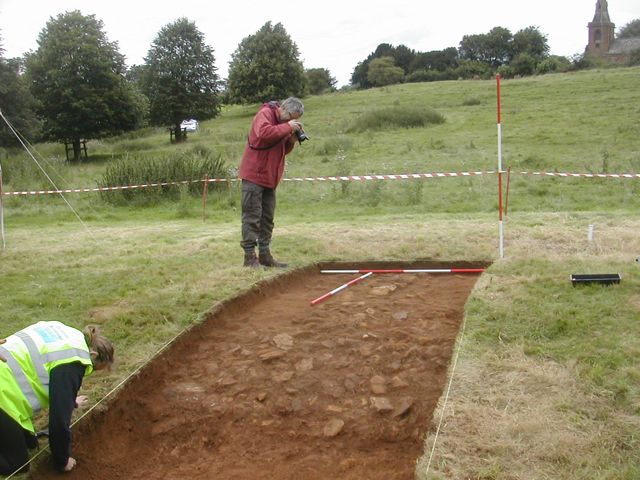
revealing a wall running down the middle of the trench, how lucky was that - towards the edge of the platform... and here's Chris photographing it all ...
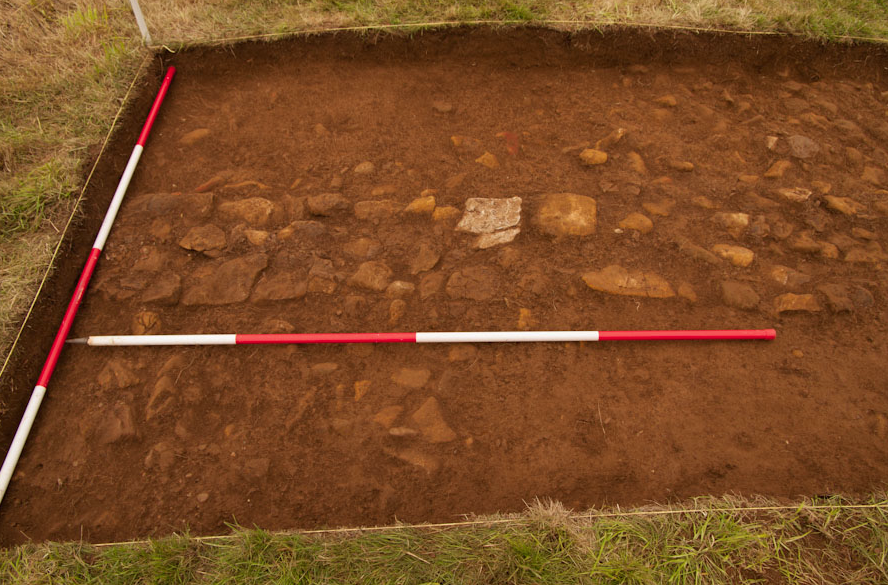
... and here's his picture (Photo by Chris Mitchell).
You can see coverage of the whole day on Chris's web pages here.Well the weather let us down again - we were expecting rain and we didn't get it! So good news and in fact we had a tremendous first day. With help from Samuel who came back for more and three new recruits: Isabel, Kathryn and Naomi, Verna and I were able to lead the team in making terrific progress. We were also delighted to see Chris Mitchell, a long term supporter of the project who came to document the first day with his usual collection of high quality images.The turf was removed and stacked by lunchtime and the surfaces revealed were cleaned up by teatime revealing a fascinating collection of walls, revetments and buried deposits and layers. Finds included some massive floor tiles and a couple of very fine microliths, possibly Mesolithic. Early indications are pushing us towards the medieval manor interpretation but it is still early days.

One of our two microliths, the blade is around 12 mm long. (Photo by Chris Mitchell)


The turf stripping begins... and once it is all off we clean up the surfaces below...
(Photos by Chris Mitchell)


revealing a wall running down the middle of the trench, how lucky was that - towards the edge of the platform... and here's Chris photographing it all ...

... and here's his picture (Photo by Chris Mitchell).
Tuesday August 28th.
A fine day for digging except we didn't - not until at least lunchtime. The excellent progress made yesterday meant we had to spend the morning in recording it all - plans, sections and context forms. Once that was out of the way we started clearing the rubble from around the wall running somewhat anomalously down the middle of the trench. It now stands three, admittedly shallow, courses high but still no sign of an associated floor surface on the east side. Meanwhile down in the moat, or the pit as we call it, clearing down onto an enormous deposit of burnt stone with some heavy duty clay tiles has revealed the presence of what may be a drain running along east to west.
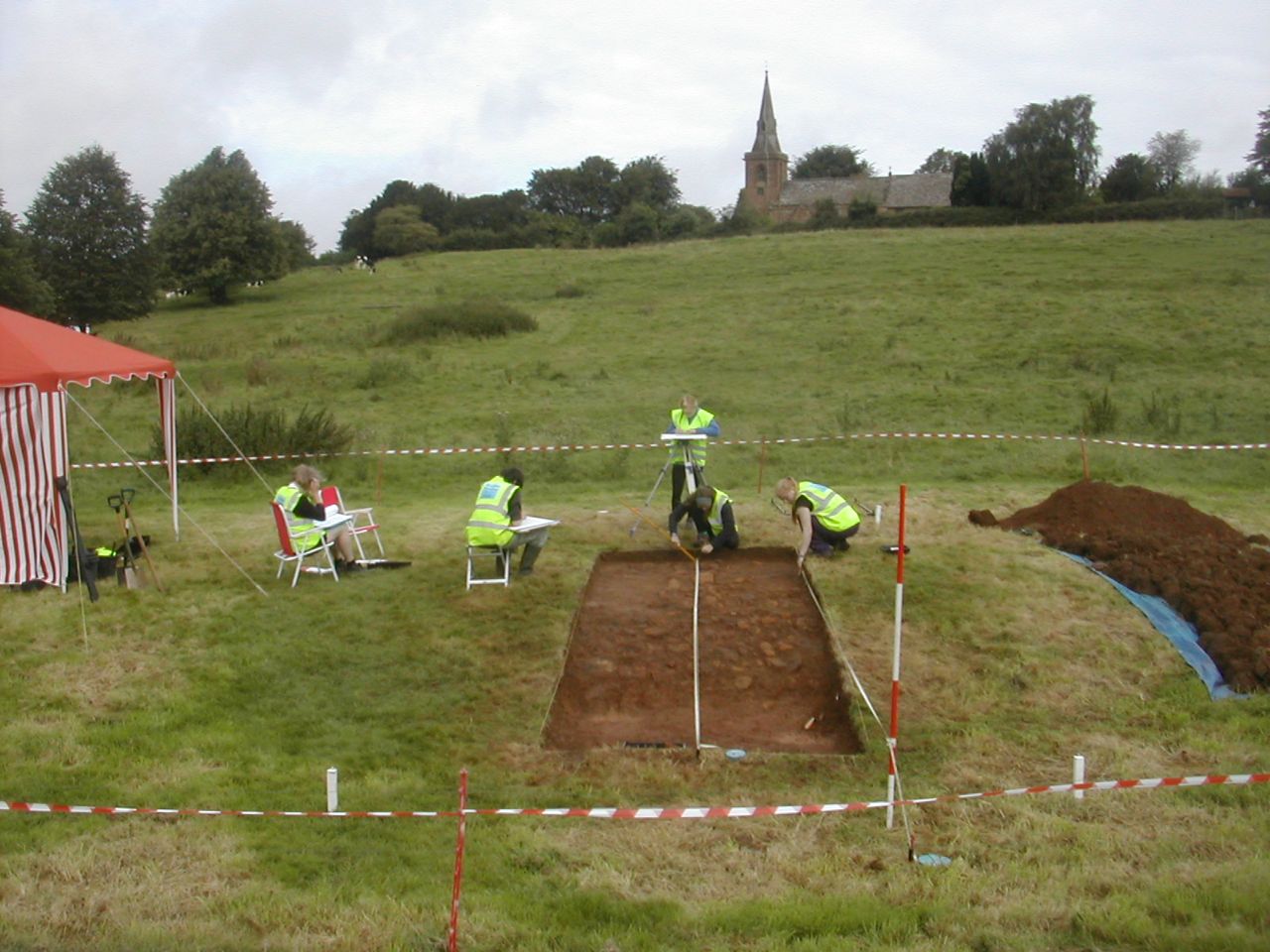
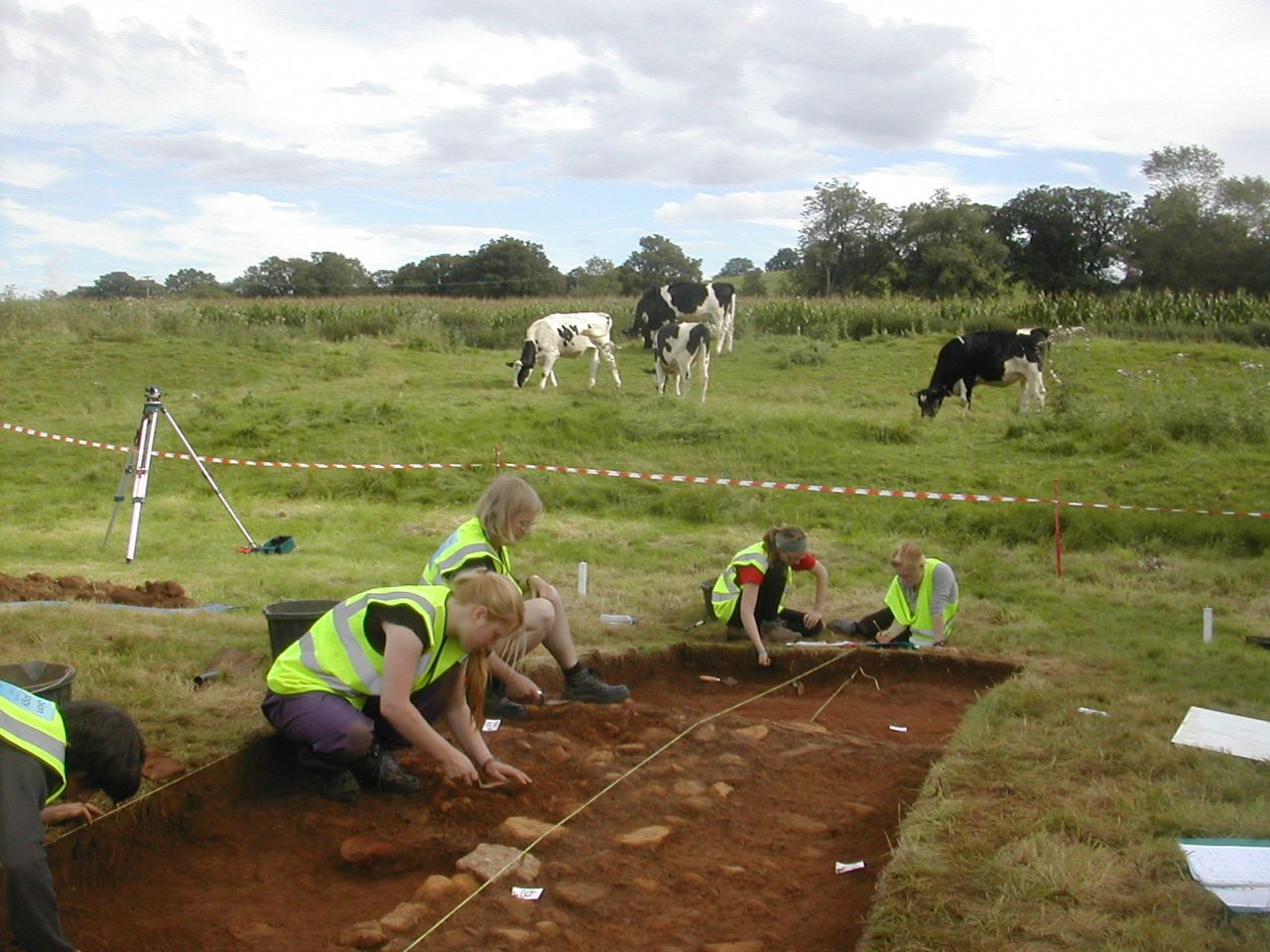
A.M. It's like working in an office, everybody recording... P.M. the digging begins again, the cows remain indifferent.
A fine day for digging except we didn't - not until at least lunchtime. The excellent progress made yesterday meant we had to spend the morning in recording it all - plans, sections and context forms. Once that was out of the way we started clearing the rubble from around the wall running somewhat anomalously down the middle of the trench. It now stands three, admittedly shallow, courses high but still no sign of an associated floor surface on the east side. Meanwhile down in the moat, or the pit as we call it, clearing down onto an enormous deposit of burnt stone with some heavy duty clay tiles has revealed the presence of what may be a drain running along east to west.


A.M. It's like working in an office, everybody recording... P.M. the digging begins again, the cows remain indifferent.
Wednesday August 29th.
Well it rained and rained and rained! Fortunately we had been fore-warned by the weather forecast and first thing Samuel and I rigged up a tarpaulin with the aid of four ranging rods, assorted pegs, pins and even skewers and lots of string. Amazingly it worked and kept us and two thirds of the site reasonably dry all day. This enabled us to pretty well complete excavation on the east side of the central wall and end the day moving over to the west. There has been much discussion on the nature of this wall and I guess the consensus is that is is probably a sleeper wall for the base plate of a timber framed building.
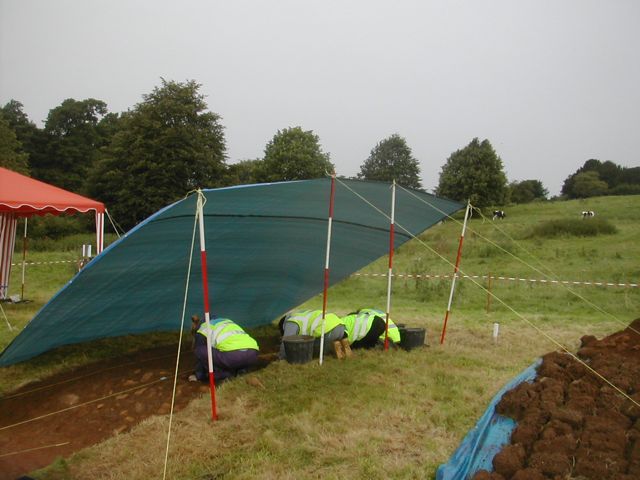
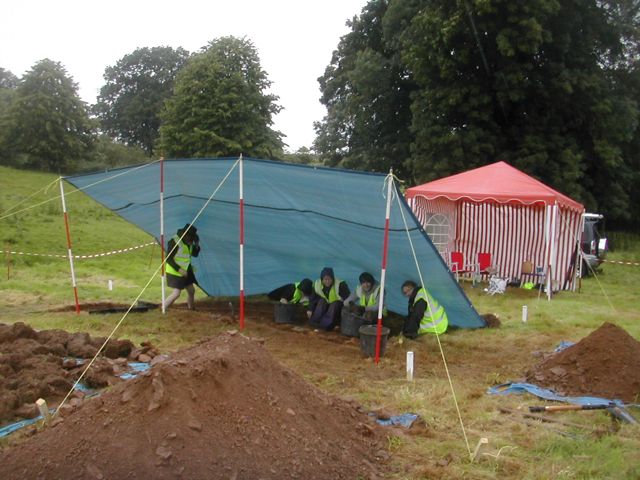
Digging under cover at the start of the day... and near the end - still smiling, mostly!
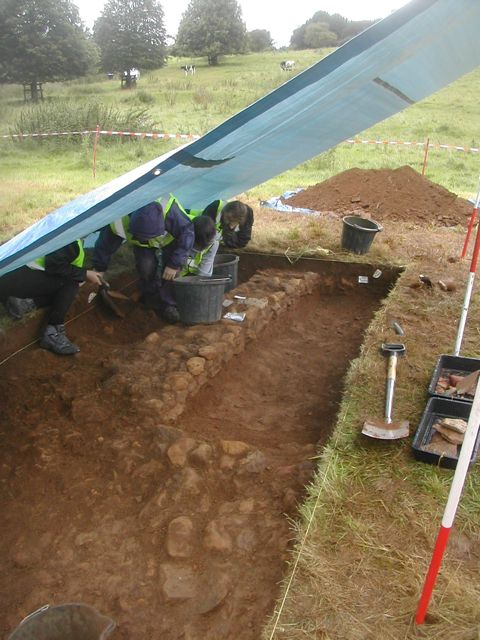
View looking north west showing the exposed east face of the central wall.
Well it rained and rained and rained! Fortunately we had been fore-warned by the weather forecast and first thing Samuel and I rigged up a tarpaulin with the aid of four ranging rods, assorted pegs, pins and even skewers and lots of string. Amazingly it worked and kept us and two thirds of the site reasonably dry all day. This enabled us to pretty well complete excavation on the east side of the central wall and end the day moving over to the west. There has been much discussion on the nature of this wall and I guess the consensus is that is is probably a sleeper wall for the base plate of a timber framed building.


Digging under cover at the start of the day... and near the end - still smiling, mostly!

View looking north west showing the exposed east face of the central wall.
Thursday August 30th.
In effect, the last day's digging with efforts concentrating on further elucidation of exactly what's going on with the wall/revetment edging the moat and also on taking out some more of the rubble fill from the moat itself and examining the cut, fill and fine pipework of a nineteenth century drain - yes we do get excited about that kind of thing! This was coupled with some intensive section and elevation drawing. The evening was also busy with the site being open from 6.00 to 8.00 and once again we were delighted to see of number of interested parties from the village and from the Warmington Heritage Group. It was particularly pleasing to welcome Alastair Muir-Beddall, one of the present occupants of the hall, to the dig.

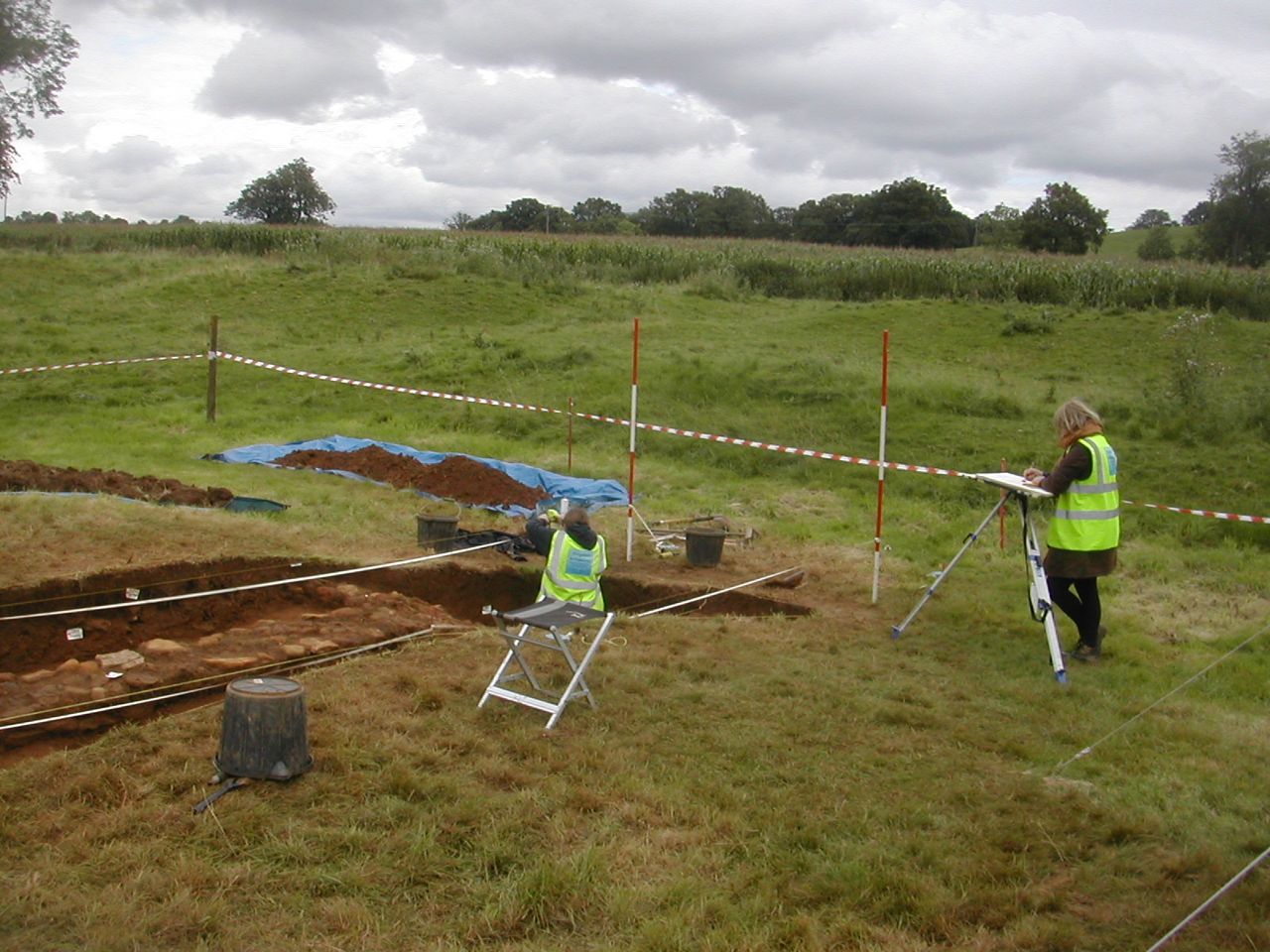
It became quite hard to fit everyone in... but we did have loads of section drawing to do.
In effect, the last day's digging with efforts concentrating on further elucidation of exactly what's going on with the wall/revetment edging the moat and also on taking out some more of the rubble fill from the moat itself and examining the cut, fill and fine pipework of a nineteenth century drain - yes we do get excited about that kind of thing! This was coupled with some intensive section and elevation drawing. The evening was also busy with the site being open from 6.00 to 8.00 and once again we were delighted to see of number of interested parties from the village and from the Warmington Heritage Group. It was particularly pleasing to welcome Alastair Muir-Beddall, one of the present occupants of the hall, to the dig.


It became quite hard to fit everyone in... but we did have loads of section drawing to do.
Friday August 31st.
The last day of digging and once again we had had to field loads of questions about why we weren't carrying on, going deeper, opening up a larger area, and so on. We explained not only the limited aims of our small scale evaluation dig but also the financial and logistical consequences of excavating a much larger area. So the day began with a massive clean up for our final series of photographs. Once that was complete we continued downwards desperately seeking some nice muddy sediments deposited in the moat. As it happened all we found was an increasing depth of rubble brought in to fill the the moat and the water table. After lunch we shared the toughest task of the whole week - putting it all back. The team worked heroically all afternoon until all the dirt was back in the hole (more or less) and all the turf was relaid (more or less) and that was it except for a celebratory, congratulatory dinner for all our energetic and enthusiastic diggers to whom a million thanks.
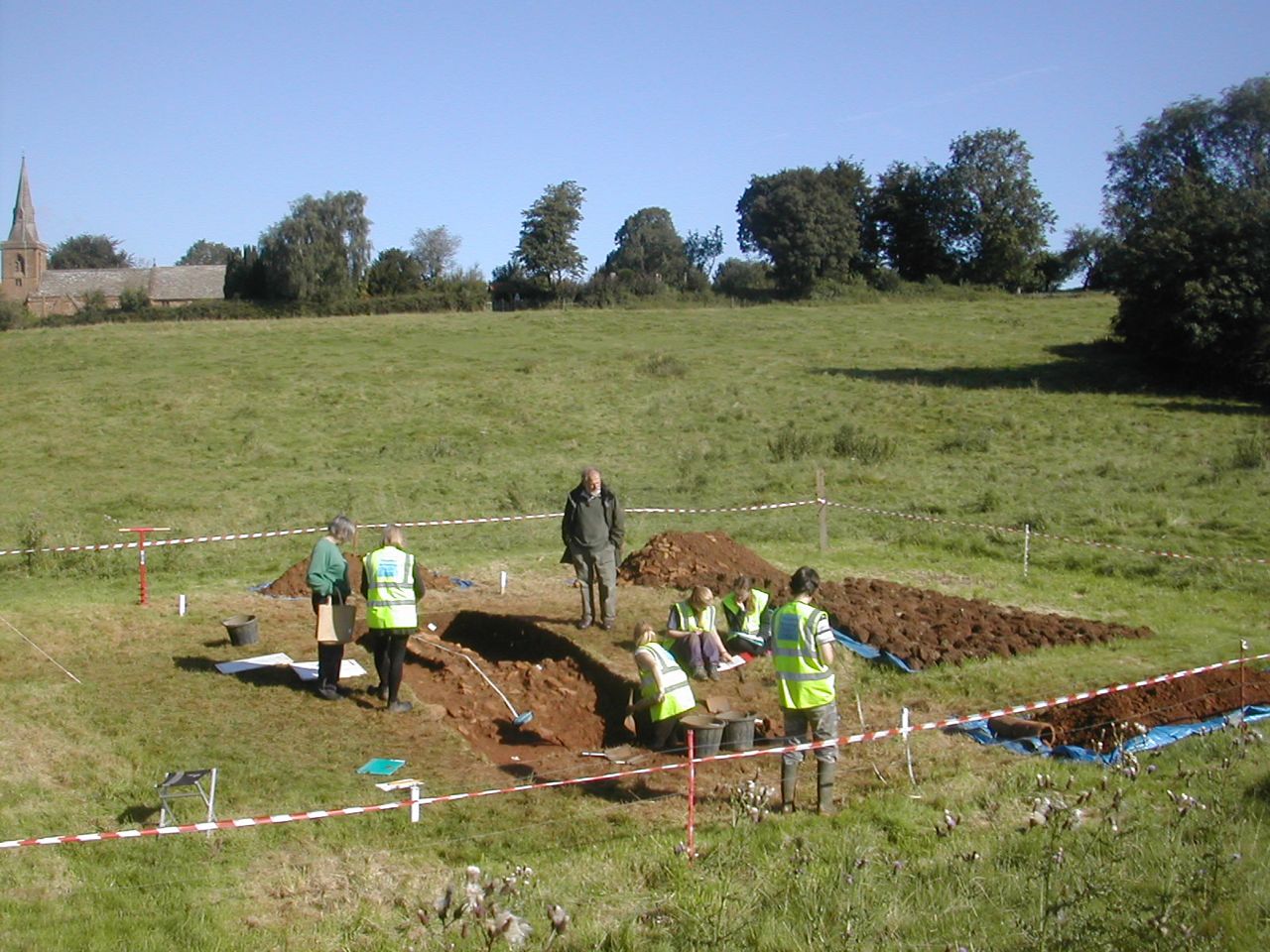
A couple of last minute visitors contemplate the site and the mysteries of single context recording and the contribution of Mr. Munsell.
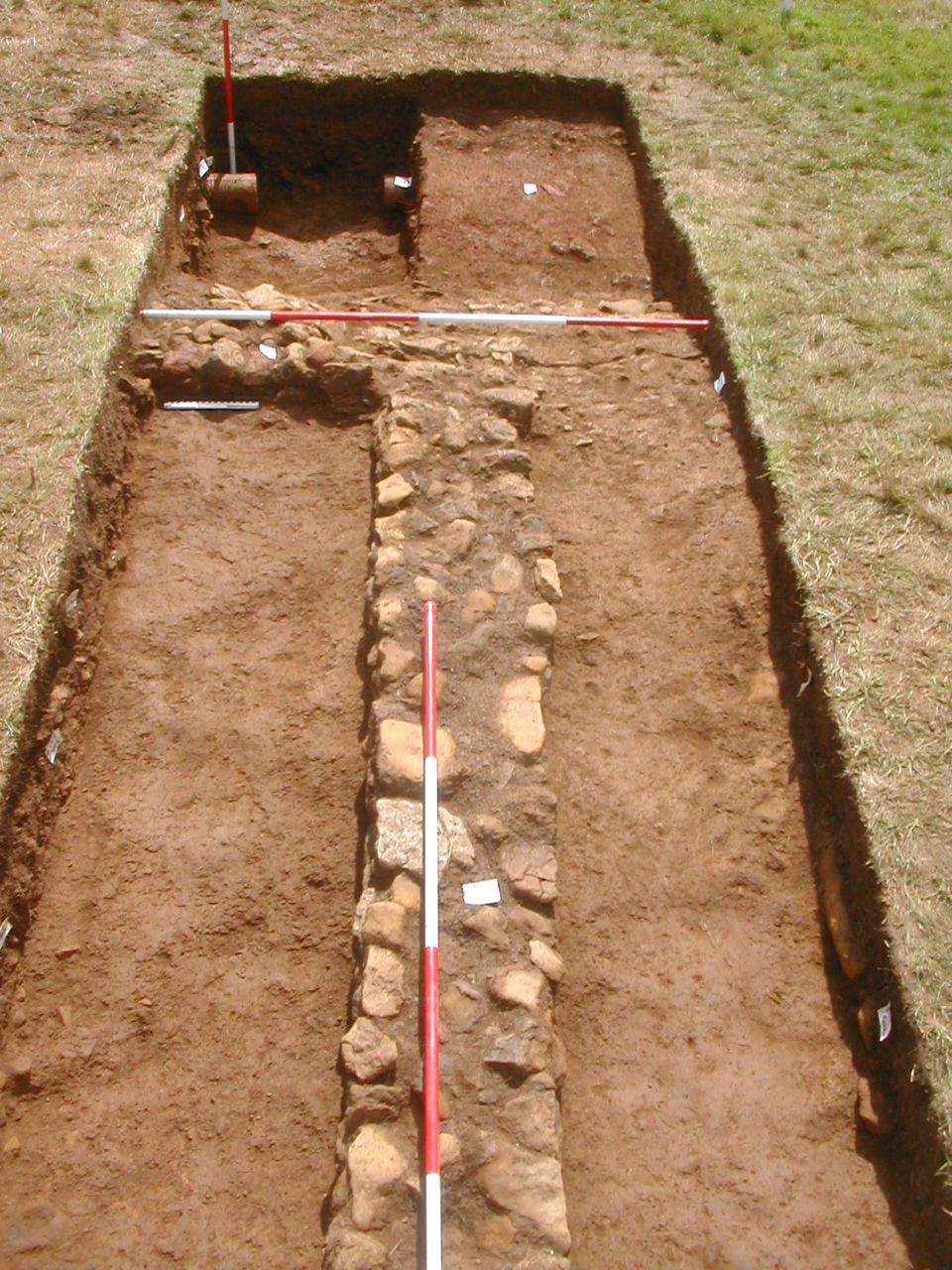
The whole trench looking south with the foundation wall for a timber sleeper running down the middle and the revetment and moat in the background.
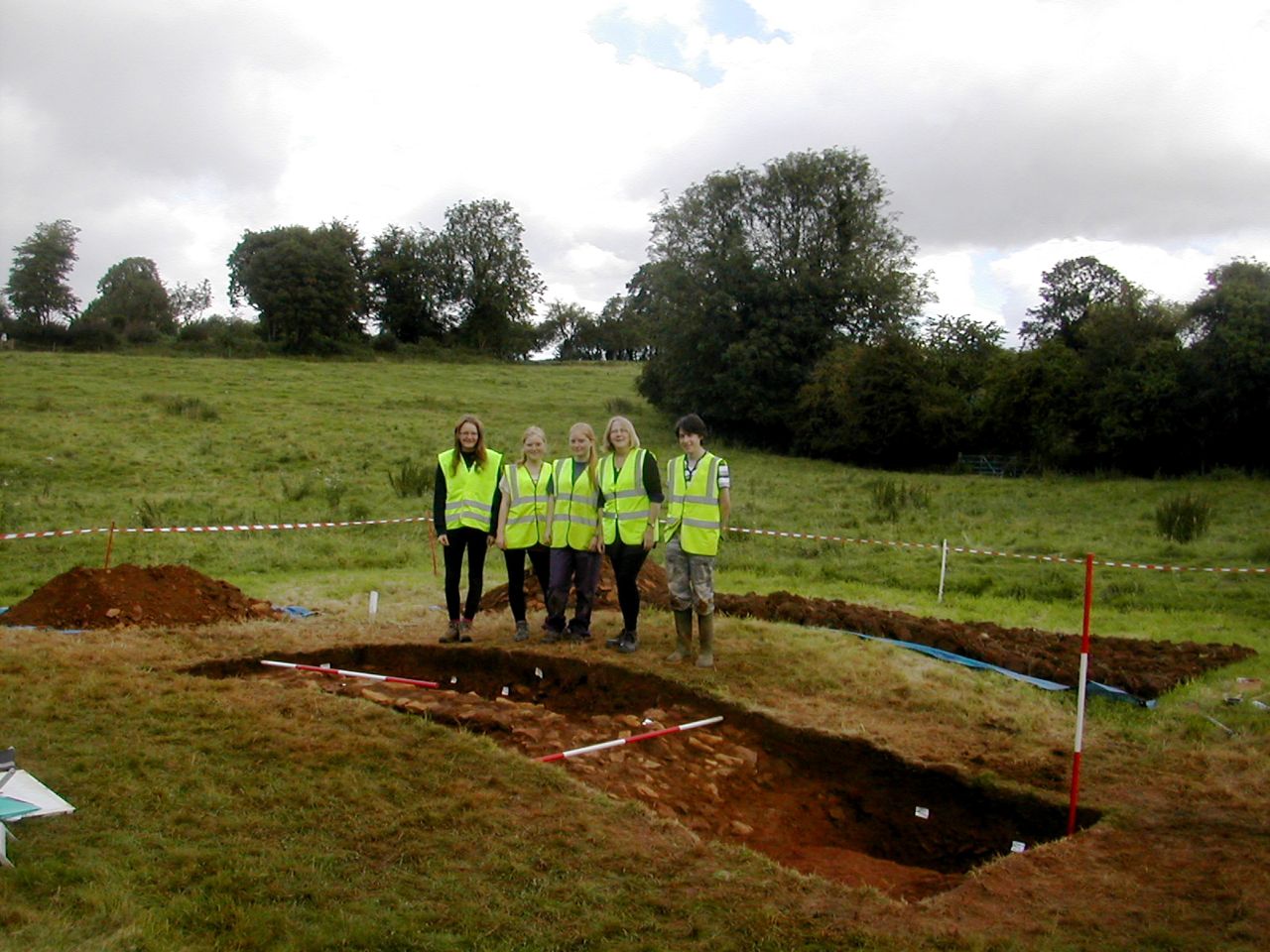

Look what we've done: at the start of the day having just finished cleaning up for photography and... at the end of the day, back-filling complete.
The last day of digging and once again we had had to field loads of questions about why we weren't carrying on, going deeper, opening up a larger area, and so on. We explained not only the limited aims of our small scale evaluation dig but also the financial and logistical consequences of excavating a much larger area. So the day began with a massive clean up for our final series of photographs. Once that was complete we continued downwards desperately seeking some nice muddy sediments deposited in the moat. As it happened all we found was an increasing depth of rubble brought in to fill the the moat and the water table. After lunch we shared the toughest task of the whole week - putting it all back. The team worked heroically all afternoon until all the dirt was back in the hole (more or less) and all the turf was relaid (more or less) and that was it except for a celebratory, congratulatory dinner for all our energetic and enthusiastic diggers to whom a million thanks.

A couple of last minute visitors contemplate the site and the mysteries of single context recording and the contribution of Mr. Munsell.

The whole trench looking south with the foundation wall for a timber sleeper running down the middle and the revetment and moat in the background.


Look what we've done: at the start of the day having just finished cleaning up for photography and... at the end of the day, back-filling complete.
DIG DIARY- Church Oakal B site
Monday August 13th to Friday August 21st. 2012

Location Plan
Monday August 13th.
After a frenetic weekend in Cropredy, with 20,000 visitors descending on the village for the annual Fairport Cropredy Convention music festival, it was quite hard to get going on Monday morning but we did and by 10.00 we were ready to start digging. Many thanks are due to Mick who put up an electric fence for us on Friday and watched the cattle learning not to like licking it and Richard and Stephen who popped over to mow and strim the grass so we had a level playing field - well not quite - to get going on.
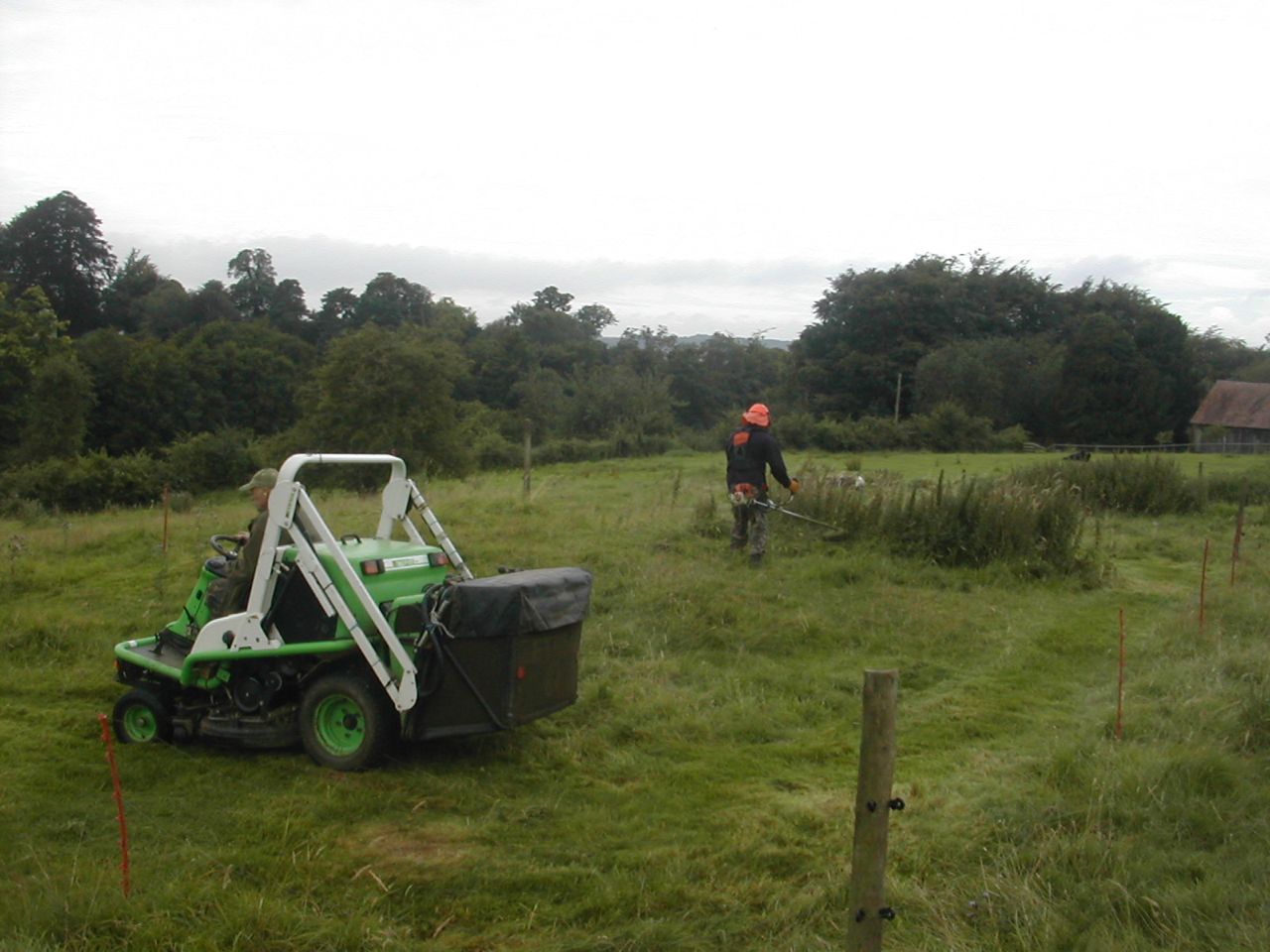
Richard and Stephen tame the grass.
After a frenetic weekend in Cropredy, with 20,000 visitors descending on the village for the annual Fairport Cropredy Convention music festival, it was quite hard to get going on Monday morning but we did and by 10.00 we were ready to start digging. Many thanks are due to Mick who put up an electric fence for us on Friday and watched the cattle learning not to like licking it and Richard and Stephen who popped over to mow and strim the grass so we had a level playing field - well not quite - to get going on.

Richard and Stephen tame the grass.
Our
first task was to position accurately four grid points from which our
measurements would be made and then mark out accurately the actual 2 x
4 metre area we would be exploring. Thanks to Verna and a new volunteer
Samuel for helping with this and for their hard work through the rest
of the day.
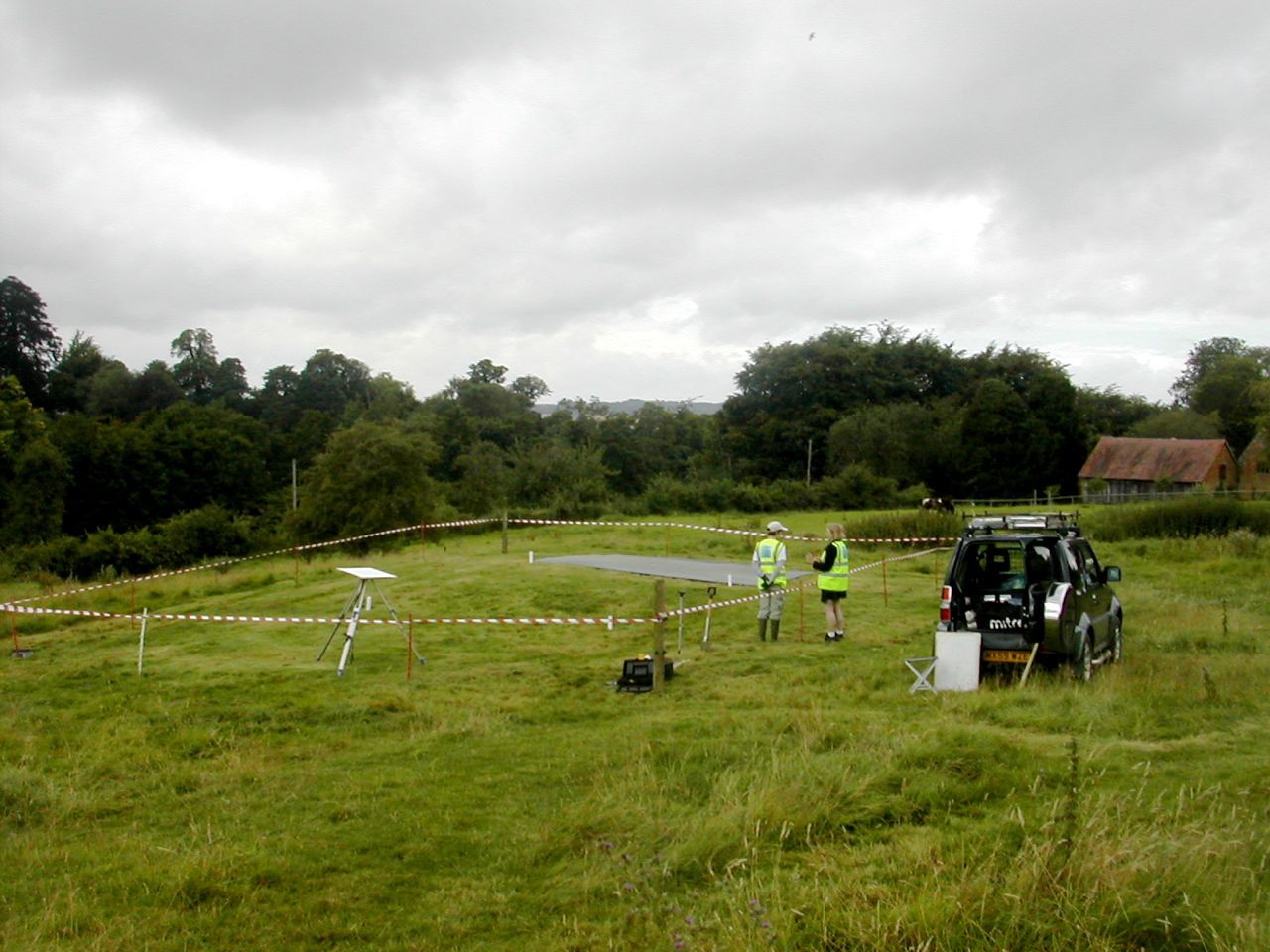
All set up and ready to go, Verna and Samuel discuss the next step.

All set up for photography but unfortunately...
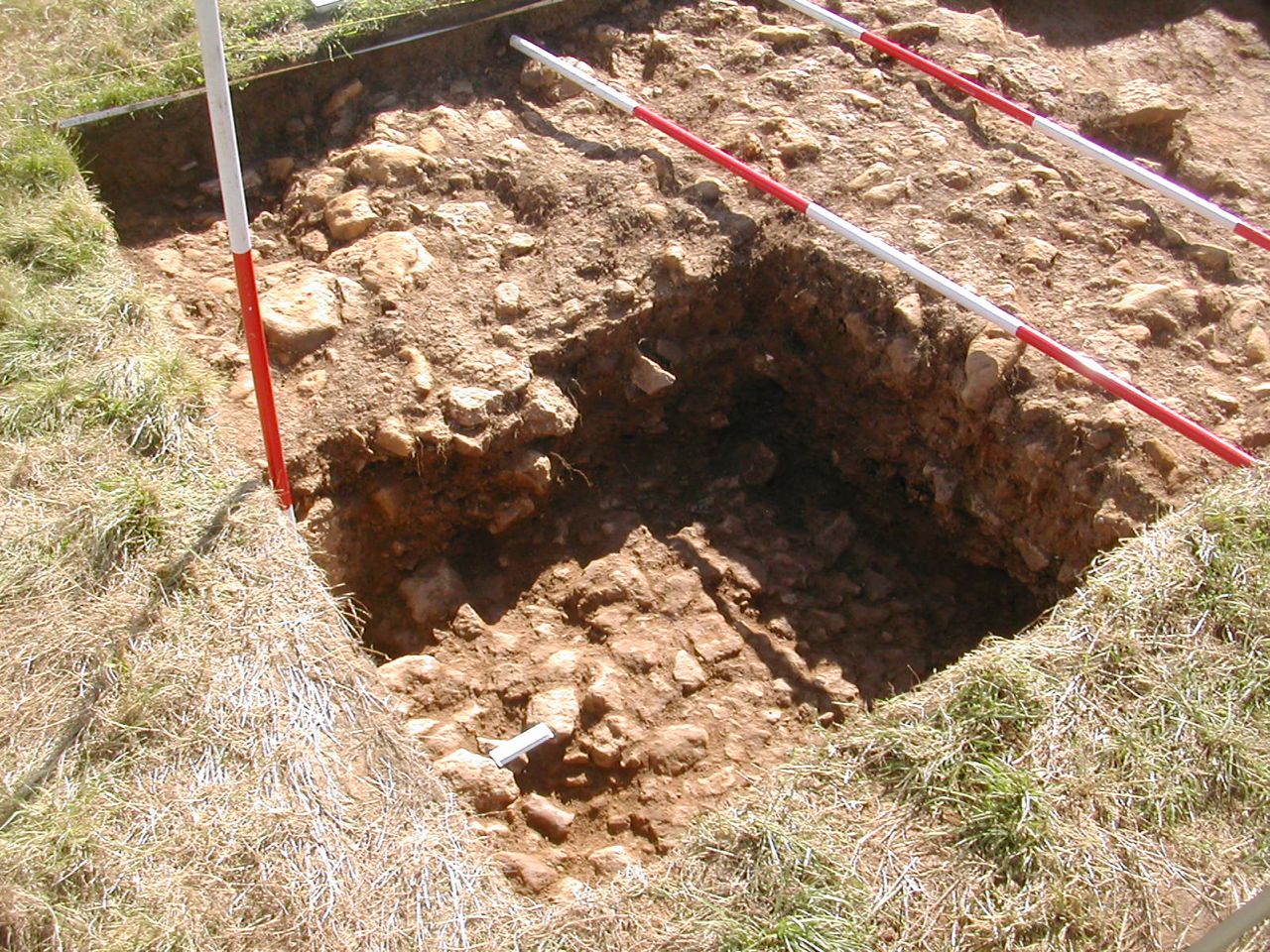
too many shadows.

All set up and ready to go, Verna and Samuel discuss the next step.
Hard
labour began with the ever popular job of deturfing. Verna went round
with a lawn edger to get us a nice neat edge to the trench whilst
Samuel and I stripped the turf and carefully stacked it for relaying at
the end of the week. Not a lot came out of the topsoil, a few tile
fragments and the odd piece of china, indications perhaps that there
has been little disturbance to the site post-demolition. A rubble
spread covering pretty well the whole area emerged from under the
top-soil and it was pretty clear from the way it was profiled that we
had been able to drop our trench nicely across a fairly major stone
wall giving us potential for in-sight into the inside, the outside and
the composition of the wall itself.
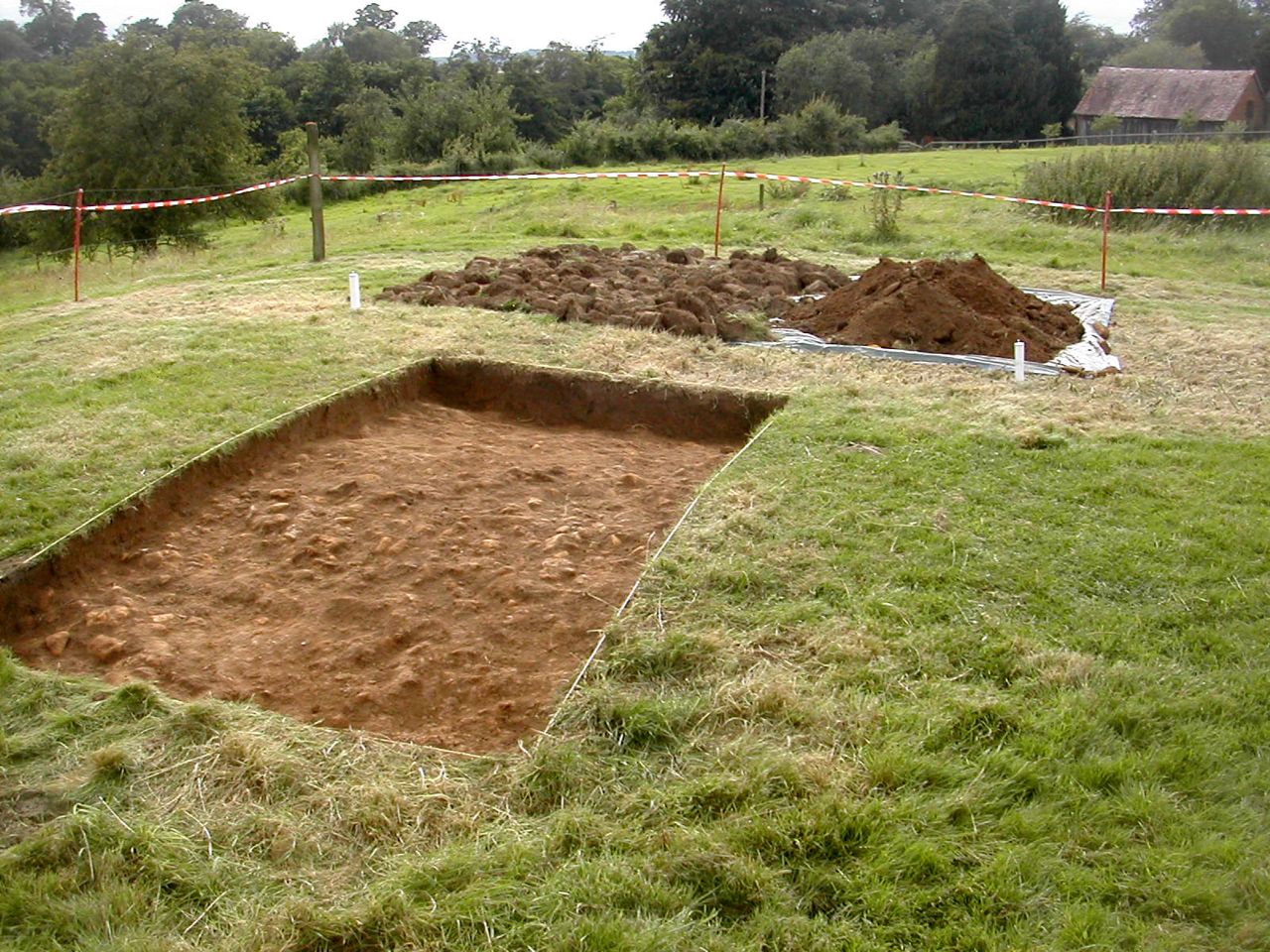
The trench at the end of day one, the wall runs across the middle.

The trench at the end of day one, the wall runs across the middle.
Tuesday August 14th.
An ideal day for digging warm, sunny and no rain. We began by given the exposed surface of the rubble spread a really good clean so Verna could photograph it.
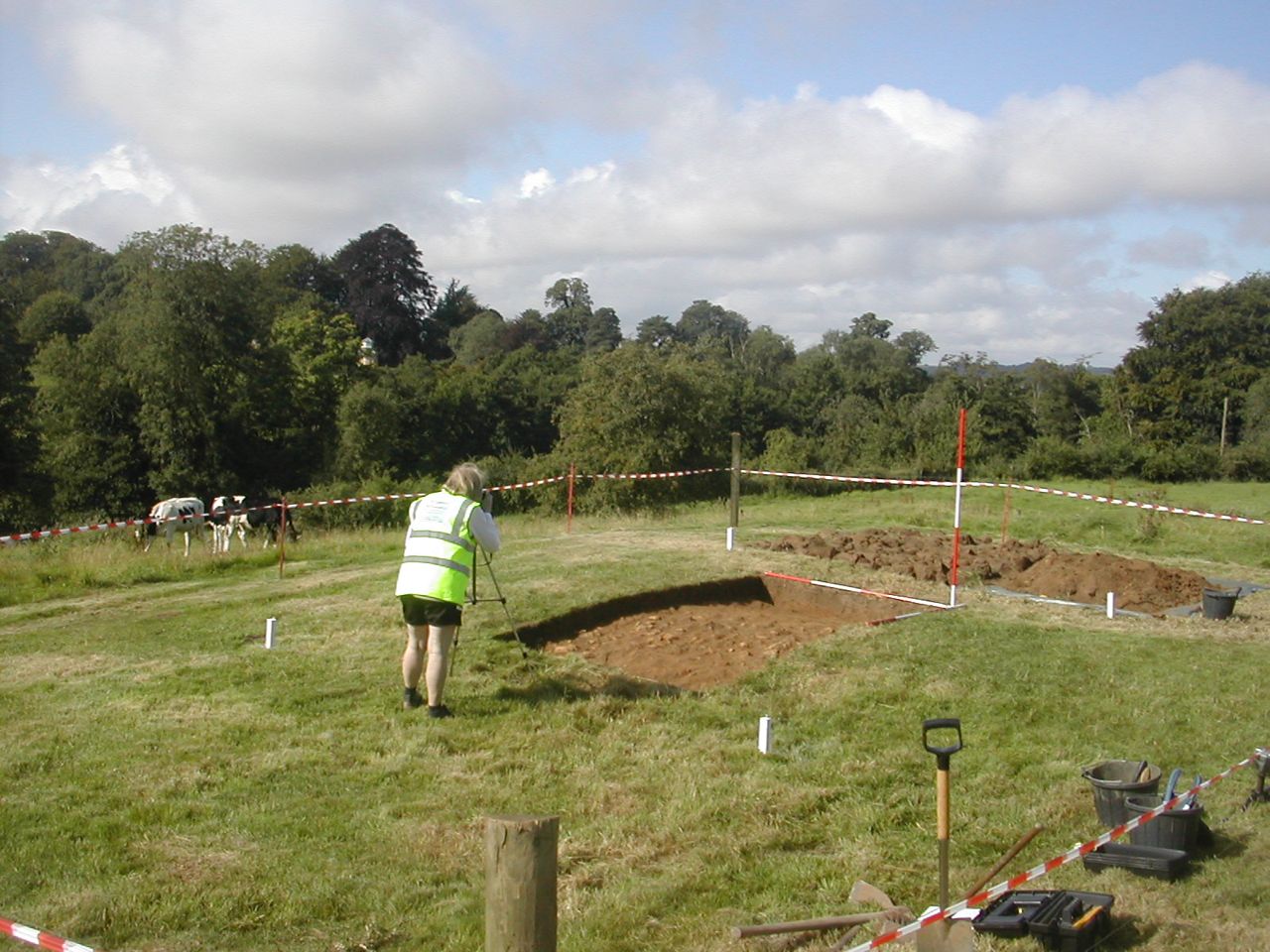
Photography at the start of day two.
An ideal day for digging warm, sunny and no rain. We began by given the exposed surface of the rubble spread a really good clean so Verna could photograph it.

Photography at the start of day two.
Then
we started removing what we are interpreting as a destruction layer
from the west end of the trench, potentially the material which had
fallen or been deposited on the inside of the building. This material
has a thickness of at least 40 cm. and the rubble has already produced
some stones which were clearly dressed facing stones. Finds have been
few but the couple of pieces of glazed pottery found so far are
suggesting a late date for the building's demolition or collapse.
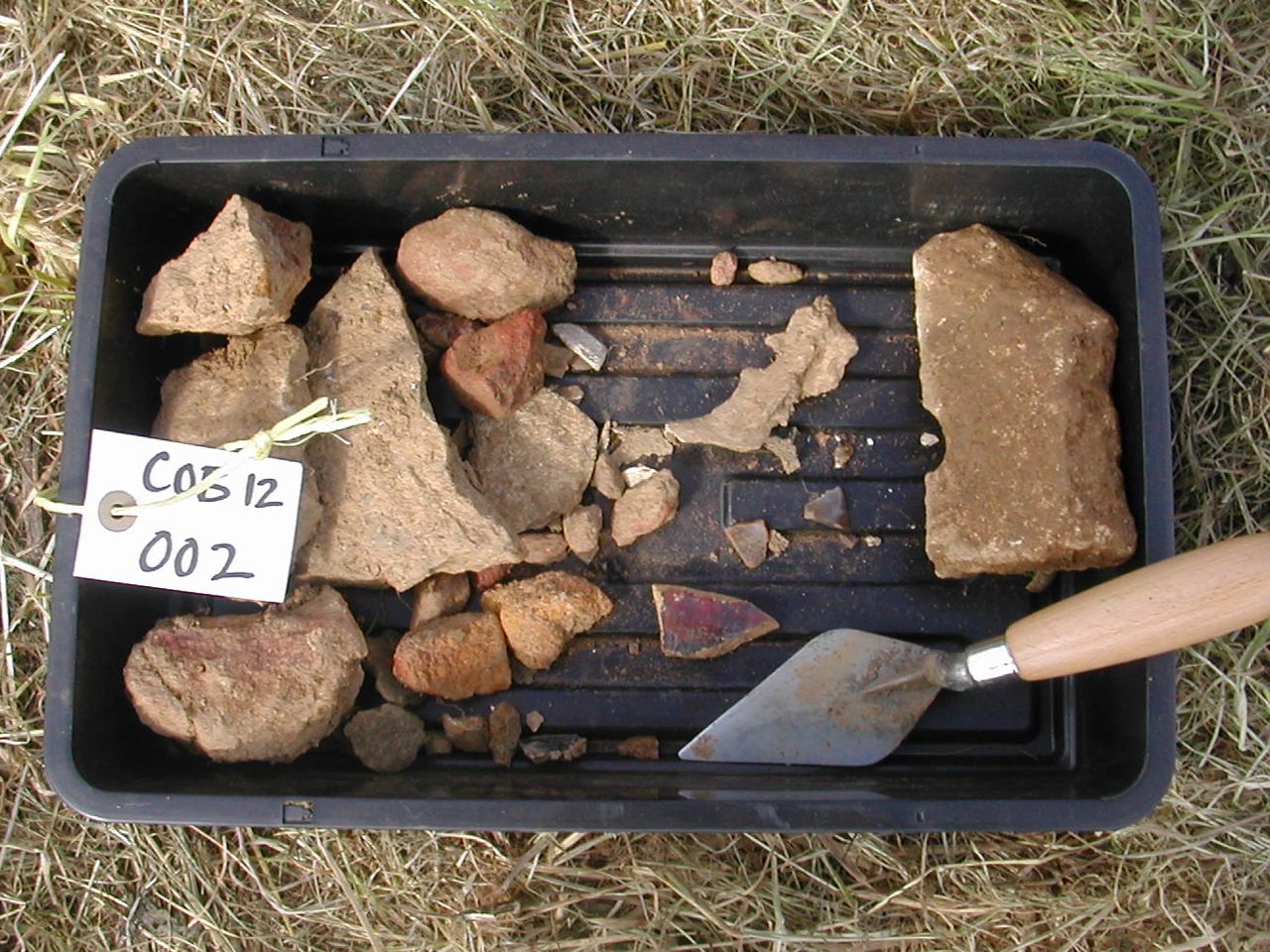
Not exactly the treasure of the pharaohs or Agamemnon's gold but a useful selection of finds from the destruction rubble.
Thursday August 16th.
Amazingly the gazebo was still in place when we arrived on Thursday morning so I walked across to the other side of the valley and took a photo which showed up the location of the dig rather nicely. Unfortunately an hour or so
later we had an enormous gust which all but caused it to take off so we had to dismantle it in something of a hurry.
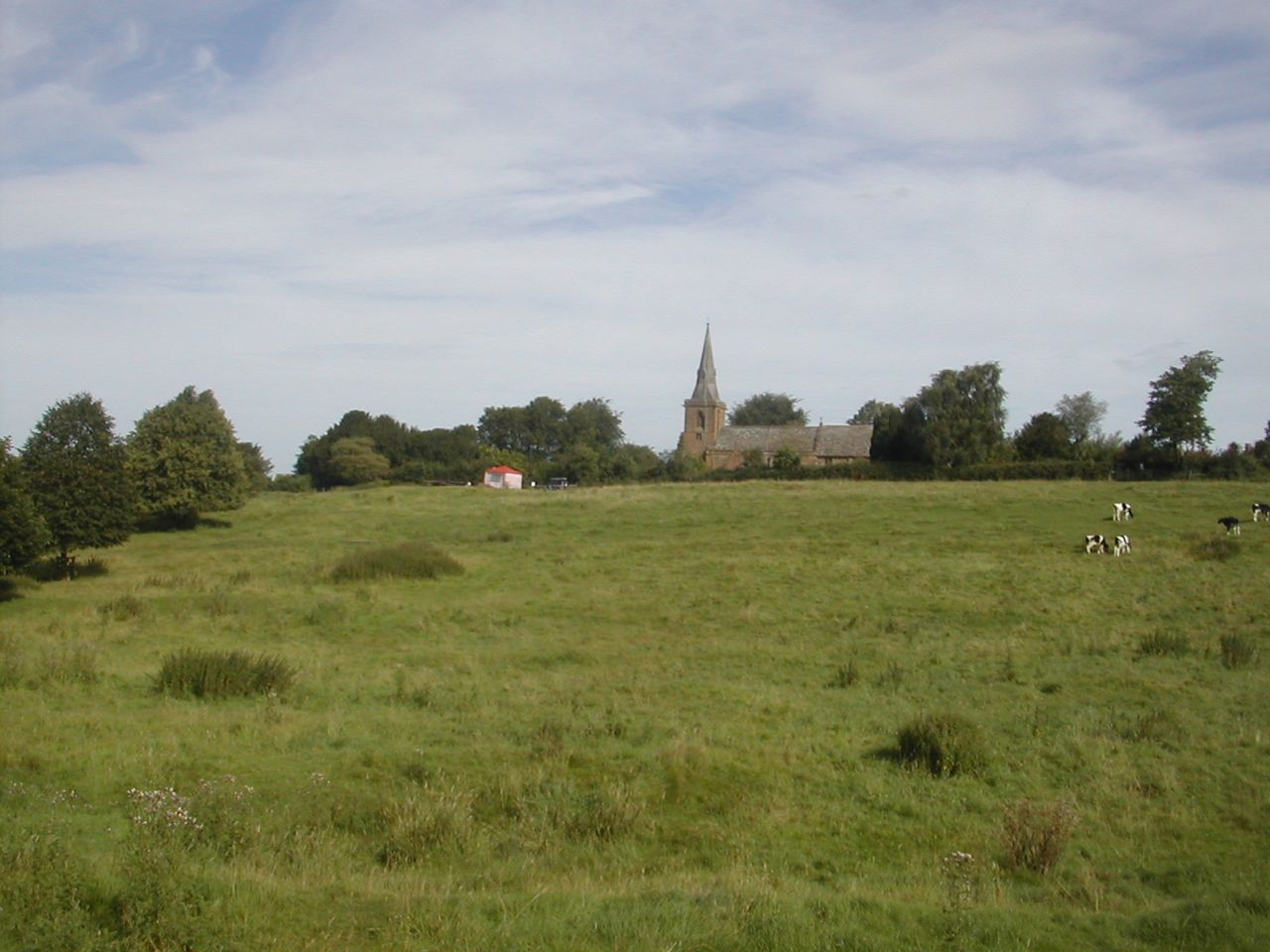
The dig location before the gazebo tried to take off, view from the south
As far as the digging was concerned it became clear that we could not completely remove the large deposits of destruction rubble in the remaining time so we concentrated on the northern half of the trench and took down two 1 metre square areas. the western most area which we had assumed from the shape of the earthworks was inside turned out to be outside and the rubble simply merged with underlying deposits with no appreciable surfaces of any kind.
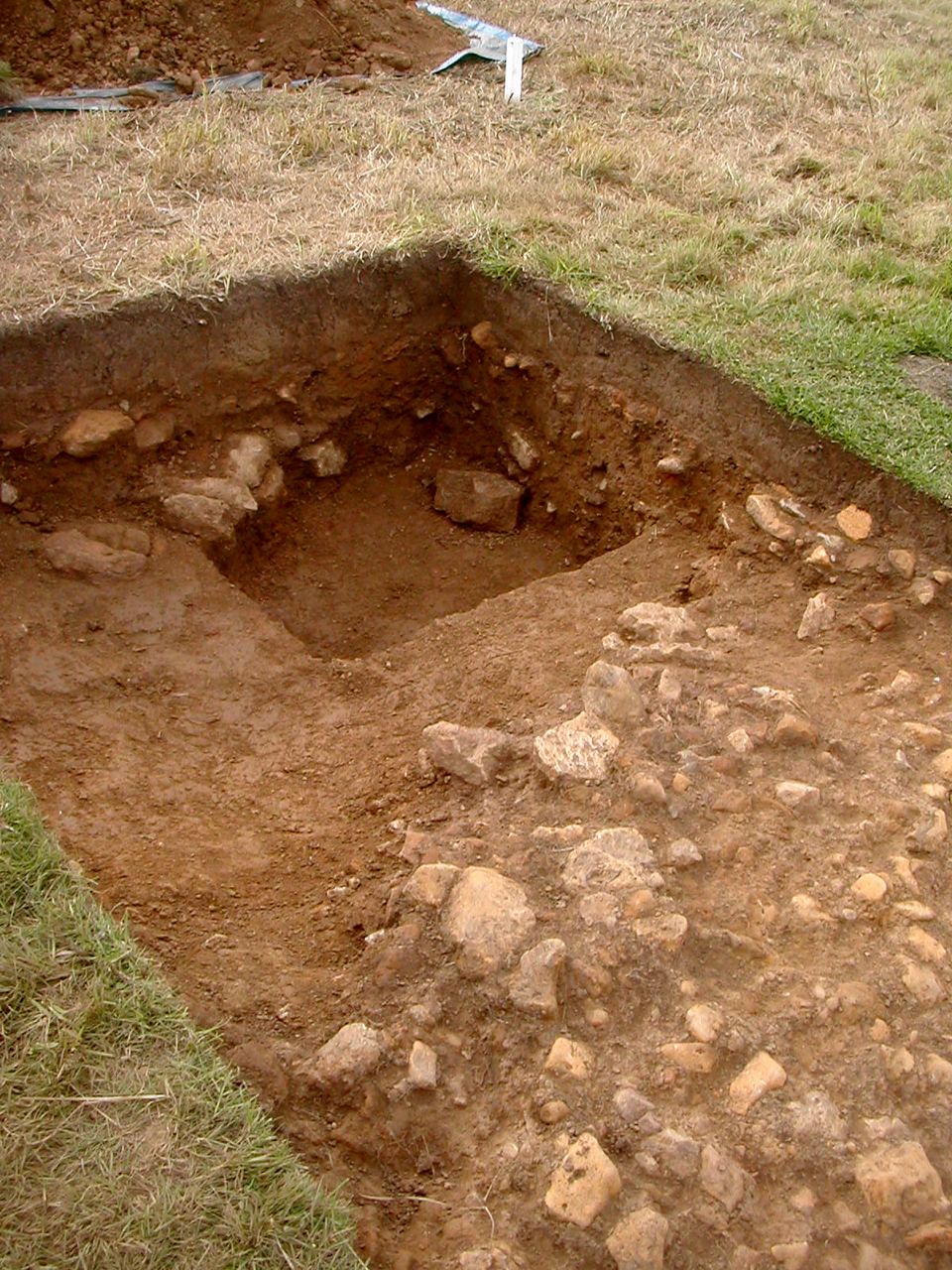
Test pit west of the wall - rubble, rubble and rubble

Not exactly the treasure of the pharaohs or Agamemnon's gold but a useful selection of finds from the destruction rubble.
Time
was spent in the afternoon further defining the character of the wall
in an attempt to distinguish between collapsed material and walling
still in situ. More to be done on this tomorrow.
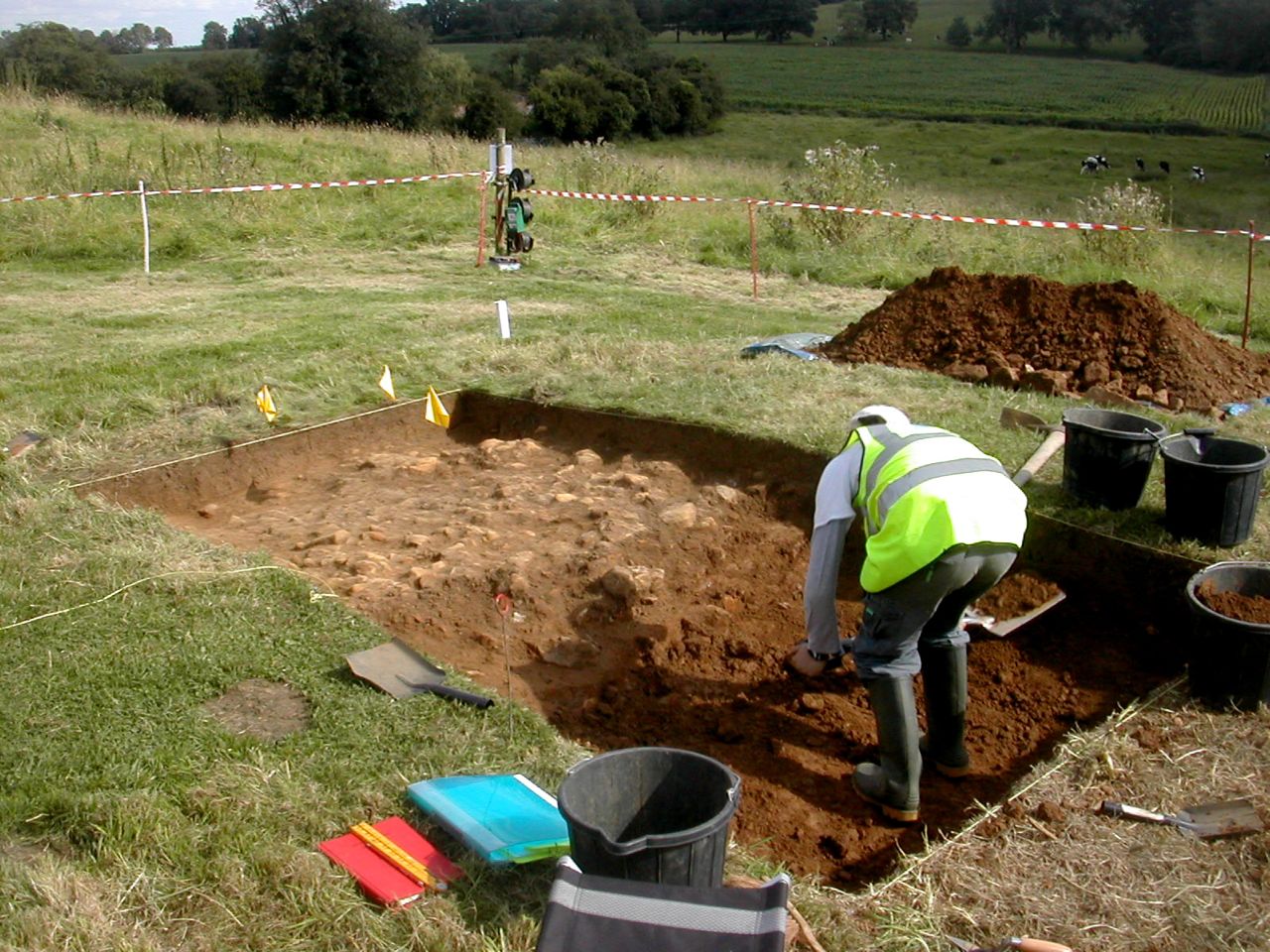

Wednesday August 15th.
Well the forecast was pretty dire so we took over the gazebo in the morning and after something of a battle were able to put it up over two thirds of the trench. This meant that we were able to work pretty uninterrupted through the day removing more destruction rubble and drawing the remains of the wall until around 3.00 when the thunder and lightning began! At this point we evacuated our hill top leaving the gazebo behind. I wonder what the chances are of it still standing by tomorrow morning?

Despite a distinct list the gazebo enabled to carry on through the best part of a very stormy day.
Well the forecast was pretty dire so we took over the gazebo in the morning and after something of a battle were able to put it up over two thirds of the trench. This meant that we were able to work pretty uninterrupted through the day removing more destruction rubble and drawing the remains of the wall until around 3.00 when the thunder and lightning began! At this point we evacuated our hill top leaving the gazebo behind. I wonder what the chances are of it still standing by tomorrow morning?

Despite a distinct list the gazebo enabled to carry on through the best part of a very stormy day.
Amazingly the gazebo was still in place when we arrived on Thursday morning so I walked across to the other side of the valley and took a photo which showed up the location of the dig rather nicely. Unfortunately an hour or so
later we had an enormous gust which all but caused it to take off so we had to dismantle it in something of a hurry.

The dig location before the gazebo tried to take off, view from the south
As far as the digging was concerned it became clear that we could not completely remove the large deposits of destruction rubble in the remaining time so we concentrated on the northern half of the trench and took down two 1 metre square areas. the western most area which we had assumed from the shape of the earthworks was inside turned out to be outside and the rubble simply merged with underlying deposits with no appreciable surfaces of any kind.

Test pit west of the wall - rubble, rubble and rubble
On
the other hand the area to the east of the wall proved equally rubble
packed but eventually cleaned down on to a laid surface of the much
harder grey lias. As a bonus we began to find significant quantities of
medieval pottery just above this surface. It proved a long day as I
returned to the site for an open evening from 6.00 to 8.00 which turned
out to be very worthwhile with nearly 30 locals - and some not so local
- strolling out to view the dig.
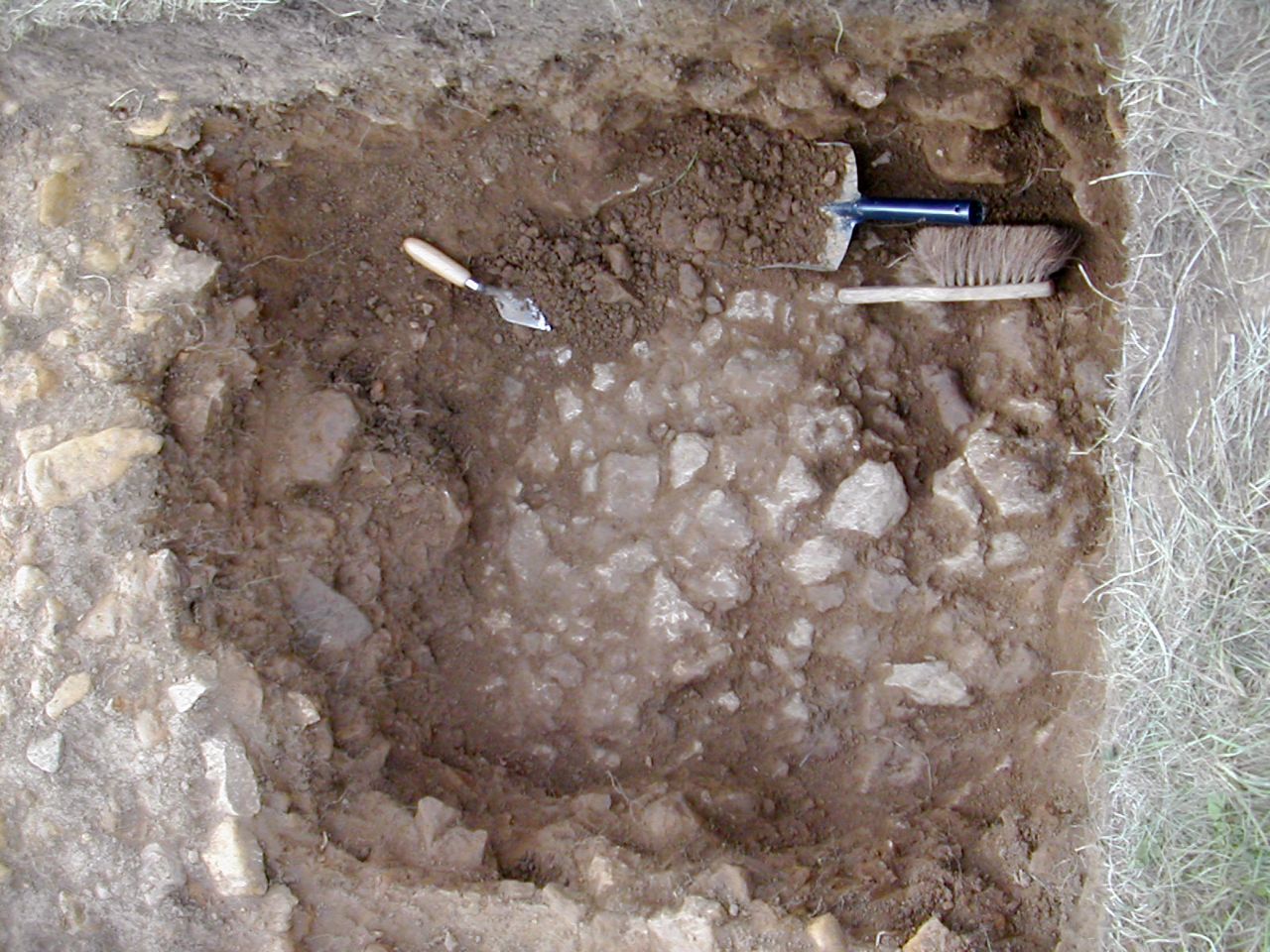
A vertical view of our early floor surface at an early stage in its excavation
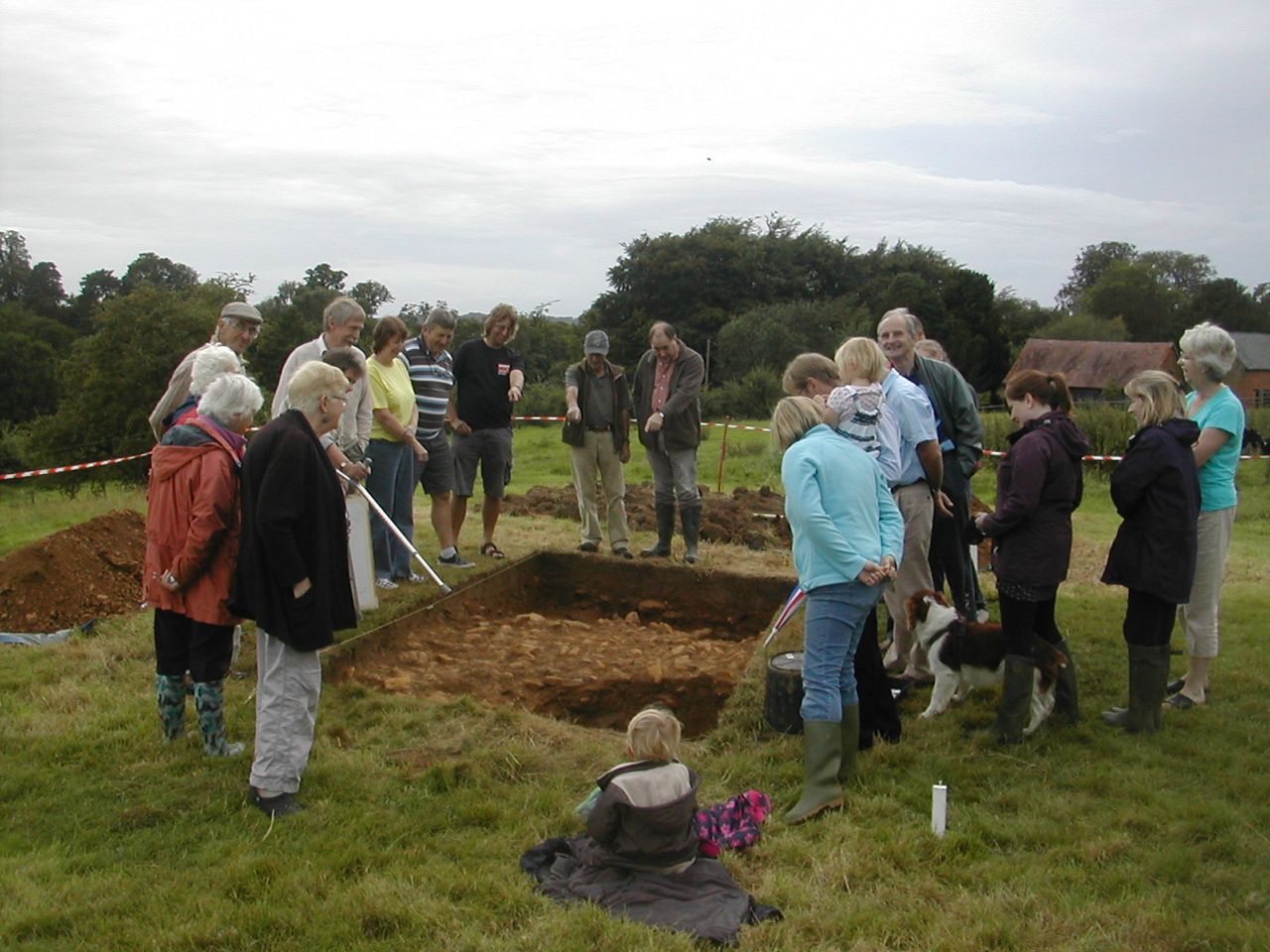
The good people of Farnborough, and further afield, marvel at the archaeological riches before them... kind of.

A vertical view of our early floor surface at an early stage in its excavation

The good people of Farnborough, and further afield, marvel at the archaeological riches before them... kind of.
Friday August 17th.
Well this was the last day in theory and the plan was to spend a little time trying to tease out some more information about how the wall was constructed then it was to be recording and back-filling. That, of course, didn't allow for the rain, so in the end we had to call a halt shortly after lunch so Monday will now be the final day.
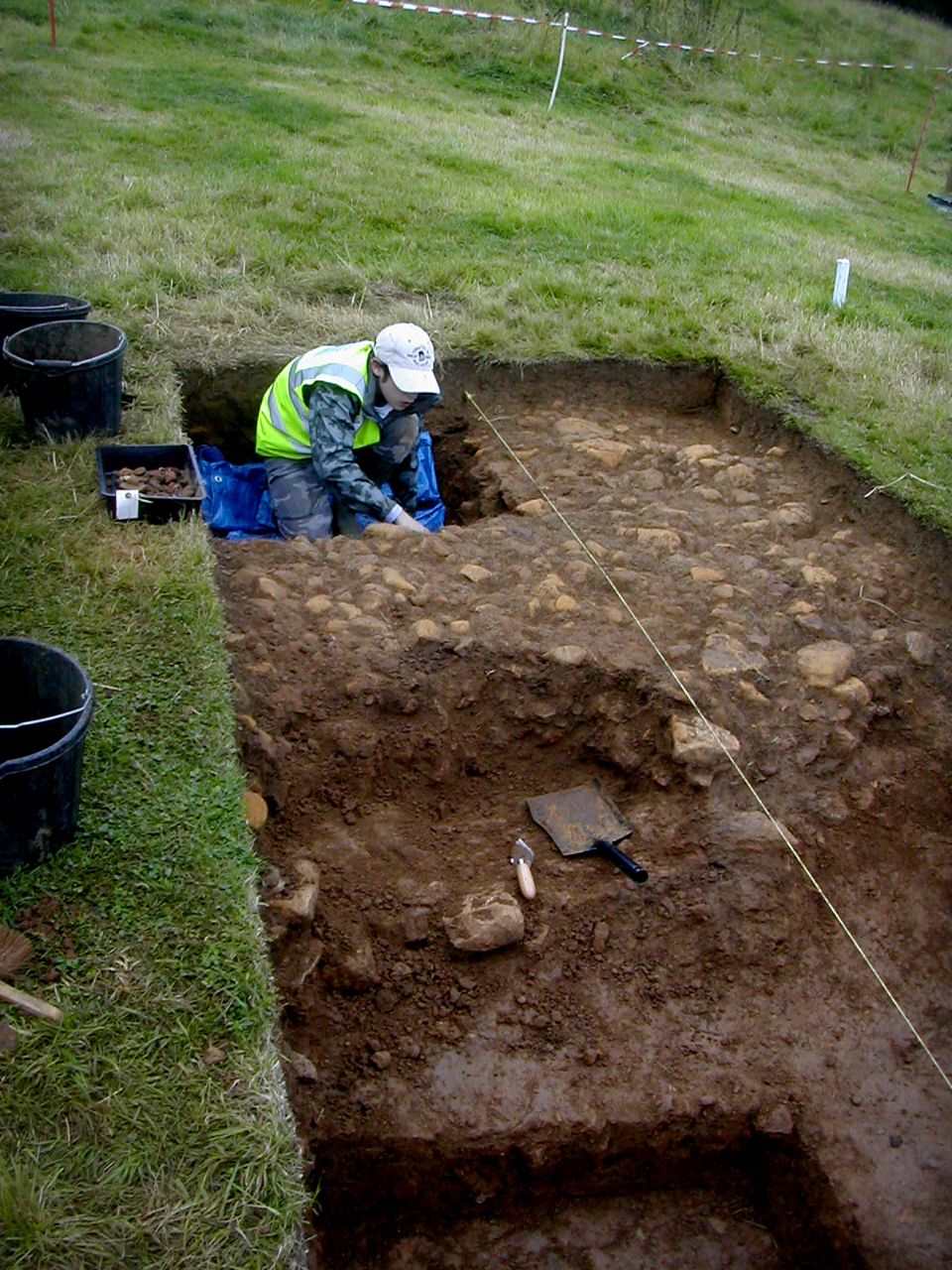
Nibbling away at the wall. It's really difficult to differentiate between the rubble and mud that formed the core of the wall and the rubble and mud that slumped down when the facing stones were removed.
Well this was the last day in theory and the plan was to spend a little time trying to tease out some more information about how the wall was constructed then it was to be recording and back-filling. That, of course, didn't allow for the rain, so in the end we had to call a halt shortly after lunch so Monday will now be the final day.

Nibbling away at the wall. It's really difficult to differentiate between the rubble and mud that formed the core of the wall and the rubble and mud that slumped down when the facing stones were removed.
Monday August 20th.
There were still a lot of photographs to take but sadly when we went back on Monday afternoon to do this it was too sunny! Strange but true. A nice even light is best for photographing most excavated surfaces as you don't have to cope with the contrast between between light and shadow.
There were still a lot of photographs to take but sadly when we went back on Monday afternoon to do this it was too sunny! Strange but true. A nice even light is best for photographing most excavated surfaces as you don't have to cope with the contrast between between light and shadow.

All set up for photography but unfortunately...

too many shadows.
Tuesday August 21st.
So back the following day which really was the last day with photography, planning, form-filling, section drawing then every archaeologist's joy... the back-filling.
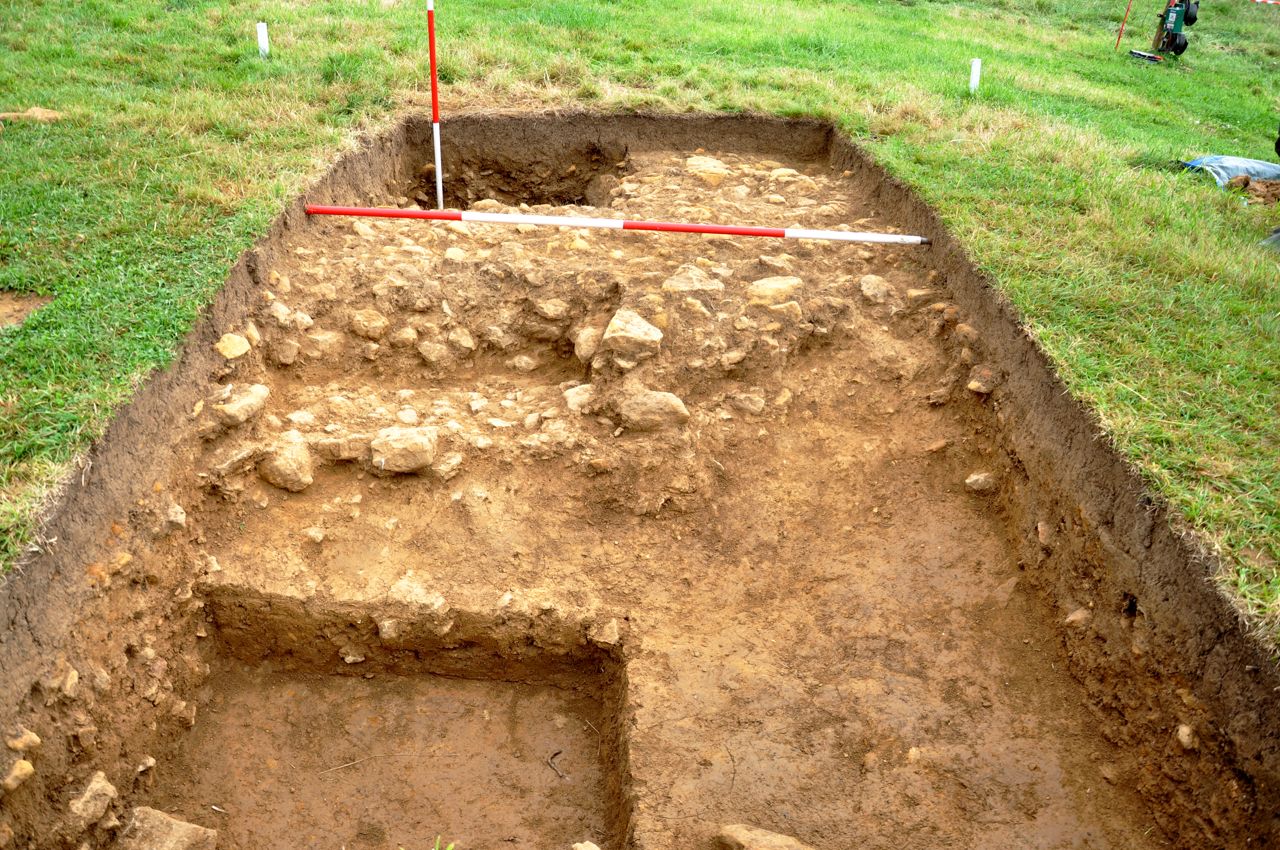
The lighting was more even. This is a view looking east showing something of the structure of the wall.

Relating the level of the section to the site datum using an optical level and staff.
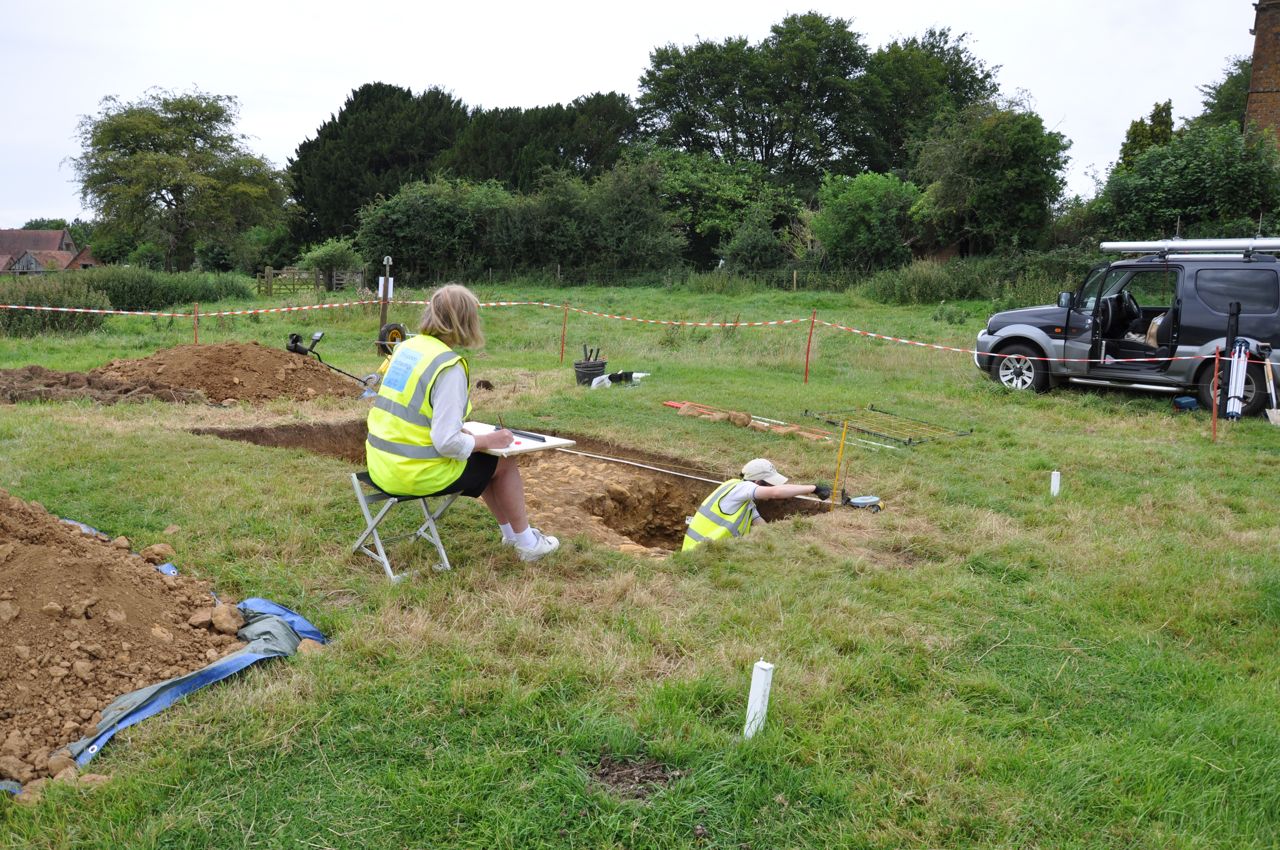
Drawing the section on the north face of the trench.

The back-filling complete and the turf re-instated... it's as if we had never been there.
So back the following day which really was the last day with photography, planning, form-filling, section drawing then every archaeologist's joy... the back-filling.

The lighting was more even. This is a view looking east showing something of the structure of the wall.

Relating the level of the section to the site datum using an optical level and staff.

Drawing the section on the north face of the trench.
Now all that remains to be done is the office work, about three weeks I think until a final report.

The back-filling complete and the turf re-instated... it's as if we had never been there.